When deciding upon which cities to visit on this year-long (or more) trip to Mexico, I googled “best food cities in mexico”. Taste is subjective so articles varied in their recommended cities, but there were a handful of destinations that made it to nearly every list – Puebla, Oaxaca, Mexico City, Guadalajara, Puerto Vallarta, and Merida.
Merida, the capital city of Yucatan state, is one of the most visited destinations in the Yucatan Peninsula. Known as the cultural heart and soul of the Yucatan, millions of travelers flock to Merida each year to admire its colonial architecture and taste its fantastic regional cuisine. Visit Merida and you’ll be treated to a bevy of delicious Yucatan dishes like cochinita pibil, salbutes, panuchos, queso relleno, and sopa de lima.
Because of its popularity and size, Merida was the only Yucatan city mentioned on those lists, but you can experience the same level of food throughout much of the Yucatan Peninsula. I spent over a week in Valladolid and was smitten by the Yucatecan cuisine there too.
If you love Mexican food like we do, then you’re going to enjoy visiting this part of Mexico. Food is a major part of the Mexican experience so be sure to look for these 25 traditional Yucatecan dishes on your next trip to the Yucatan Peninsula.
YUCATECAN FOOD QUICK LINKS
If you’re staying long enough in the Yucatan and want to really dive into Yucatecan food, then you may want to join a guided tour or take a cooking class. They’re among the best ways to learn about Mayan cuisine. Check out some of the most popular food-related tours and activities in different cities throughout the Yucatan.
TOURS & OTHER SERVICES
- Food Tours: Yucatan Food Tours
- Yucatan Cooking Classes: Merida | Riviera Maya
- SIM: Mexico SIM Card / eSIM
- Transportation: Mexico Bus Tickets
Save This on Pinterest!
No time to read this guide on Yucatecan food? Click on the save button and pin it for later!
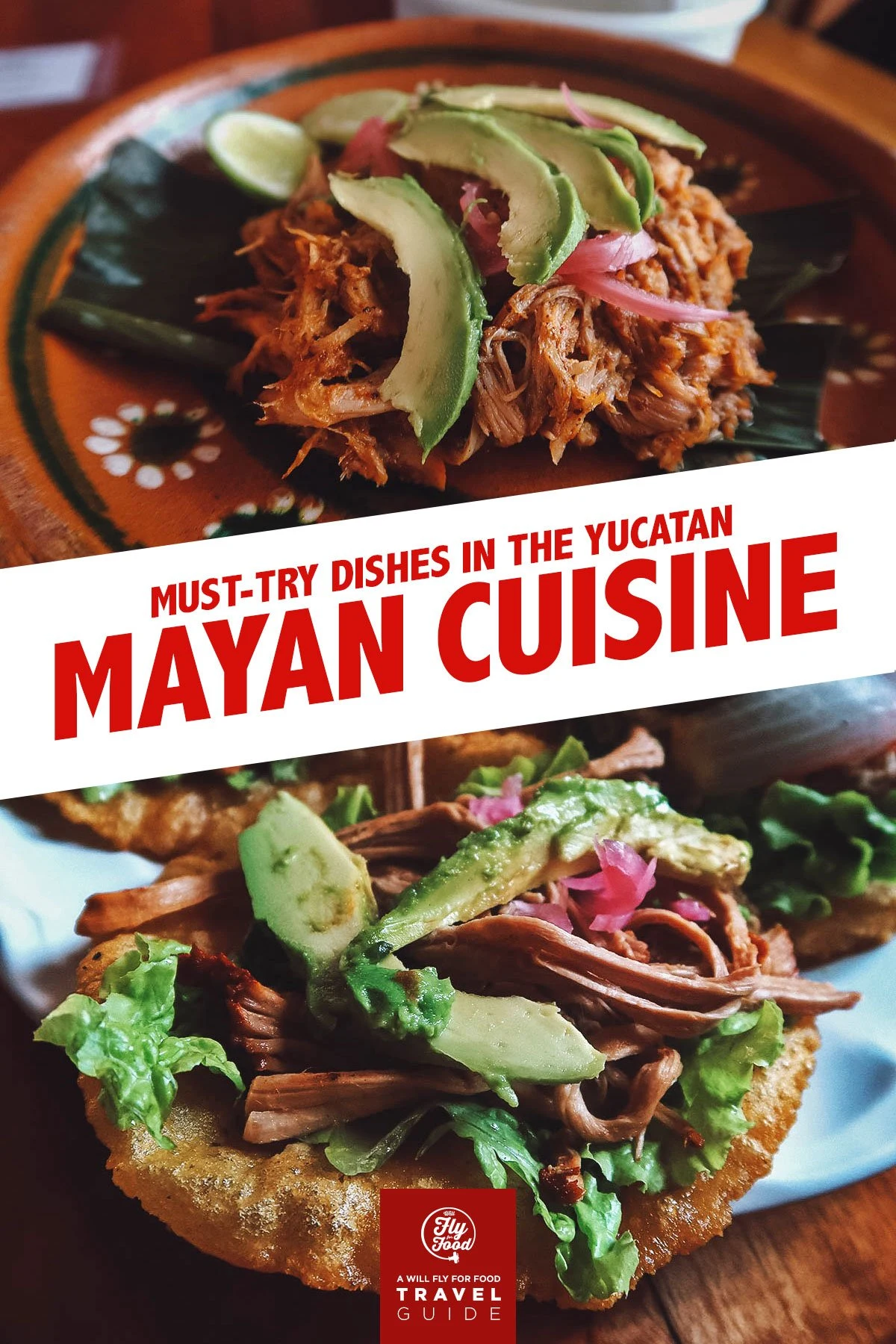
WHERE IS THE YUCATAN PENINSULA?
When used to describe a destination in Mexico, the term “Yucatan” can pertain to one of two things – Yucatan State and Yucatan Peninsula.
Yucatan State – or officially the Free and Sovereign State of Yucatan – is one of 32 states that comprise the Federal Entities of Mexico. It consists of 106 municipalities, the capital city of which is Merida.
Yucatan Peninsula refers to the large peninsula that encompasses southeastern Mexico and adjacent parts of Guatemala and Belize. The peninsula is home to three Mexican states – Yucatan, Quintana Roo, and Campeche – along with almost all of Belize and the Petén Department of Guatemala.
The Yucatan Peninsula was the central location of the ancient Mayan civilization. Vestiges of the Mayan people can be appreciated in the many archaeological sites throughout the peninsula, the most famous being Chichen Itza and Tulum. It can also be enjoyed in its regional cuisine, which is why Yucatan food can also be described as Mayan food.
In this article, we’ll talk about traditional Mayan food that you can enjoy in the Mexican part of the Yucatan Peninsula, mostly from the State of Yucatan.
WHAT IS TRADITIONAL YUCATAN FOOD?
Traditional Yucatan cuisine is heavily influenced by Mayan food, but it also draws influences from European (Spanish and Dutch), Caribbean, North African, and Middle Eastern (Lebanese) cuisines.
Much of Yucatan cooking is based on four types of pastes or recados – steak recado (steak paste), recado rojo (red paste), recado negro (black paste), and recado blanco (white paste). These elaborate mixtures form the backbone of Yucatan Mexican cuisine and provide the flavor for many traditional Yucatecan dishes.
Steak paste is used mainly for pickling and to season meat, red paste for cochinita, black paste for relleno negro, and white paste for puchero.
Yucatan cuisine utilizes many ingredients and cooking techniques, some of the most important being sour oranges, habanero chilis, achiote, chaya, and the píib.
Sour Orange
The sour orange (naranja agria) is perhaps the most important ingredient in Yucatan cuisine. Also known as Seville orange or bitter orange, this citrus fruit is native to Southeast Asia and made its way to the Yucatan by way of the Spanish.
The sour orange is ubiquitous in Yucatan food. It’s used in many Yucatan dishes like cochinita pibil, lechon al horno, escabeche oriental, poc chuc, and longaniza de valladolid. Sour orange juice is used as an ingredient in marinades and often takes the place of vinegar to brighten up dishes and help preserve food.
Habanero Chili
Yucatan cuisine makes use of different types of pepper but the habanero chili is the most important. Introduced to the peninsula by way of the Caribbean, habanero chilis are among the hottest peppers in the world and often used as an ingredient in spicy Yucatecan salsas.
Habanero chilis can also be roasted, pickled, or chopped into pieces and added directly to food. When mixed with sour orange juice, it works as an effective preservative to help keep perishable foods from spoiling under the intense tropical heat of the Yucatan.
Achiote
Like the sour orange and habanero chili pepper, achiote is a widely used ingredient in Yucatan food. Also known as annatto, seeds from the achiote tree are crushed and used as a flavoring and coloring agent in many Yucatecan dishes like cochinita pibil. Together with sour orange juice, it’s what gives this iconic Yucatecan dish its signature color and flavor.
Achiote is also the main ingredient in recado rojo. The ground-up seeds are mixed with different spices like oregano, cumin, coriander, black pepper, and cloves to form one of Yucatan cuisine’s most commonly used spice mixtures.
Chaya
Go to any Yucatan restaurant and you’ll probably see the word “chaya” on the menu. Also known as tree spinach, it refers to a nutritious chard-like shrub native to the Yucatan Peninsula.
You’ll find chaya used as an ingredient in many dishes like Yucatecan-style empanadas, huevos con chaya (eggs with chaya), tamales, and brazo de reina. Personally, I enjoyed it often as a cold refreshing beverage mixed with pineapple or lemon.
Píib
After weeks of traveling in western and central Mexico, the one thing that surprised me most about the Yucatan Peninsula was the heat. Compared to the rest of Mexico, it experiences a more tropical climate which puts food at a greater risk of spoiling.
To help preserve food, the ancient Mayans came up with a method of cooking and smoking wild game to keep it from spoiling. Freshly hunted meat would be rubbed with a spice mixture and then slow-cooked in an earthen oven called a píib or pib to keep it from spoiling on hunts that would often last several days.
Several Mayan dishes like cochinita pibil, considered by many to be the most representative dish of Yucatecan cuisine, is still prepared in this way.
MUST-TRY MAYAN DISHES IN YUCATAN CUISINE
This is by no means an exhaustive list but these are some of the most popular and delicious Yucatan foods you’ll come across when exploring this part of Mexico.
1. Cochinita Pibil
As described, cochinita pibil is considered by many to be the signature dish of Yucatecan cuisine. It was the Mayan dish featured on the Netflix series Taco Chronicles and the one I was most excited to try in Merida.
Cochinita is a traditional Yucatecan dish of slow-roasted pork marinated in sour orange juice and achiote. Cochinita literally means “baby pig” so the dish is traditionally made with a whole roasted suckling pig, though it can be prepared with pork shoulder or pork loin.
To prepare, the meat is rubbed with an achiote paste and then marinated overnight in sour orange juice. The achiote is what gives the dish its characteristic burnt orange color while the highly acidic sour orange juice acts as a meat tenderizer.
The marinated pork is then wrapped in banana leaves and slow-cooked for as long as 16 hours in an airtight píib. The result is an incredibly tender, citrusy, and smokey pork dish that’s typically eaten in tacos, tortas, salbutes, or panuchos. It can also be served on its own with pickled red onion and a side of corn tortillas. It’s absolutely delicious and one of the best Yucatan foods you can eat on the peninsula.
I had cochinita many times in the Yucatan but one of the best versions I had was from a restaurant in Valladolid (pictured below). They source their cochinita from Tixcacalcupul, a municipality about 20 km (12.4 miles) south of Valladolid. According to my server, this remote Yucatan pueblo is known for having some of the very best cochinita on the Yucatan Peninsula.
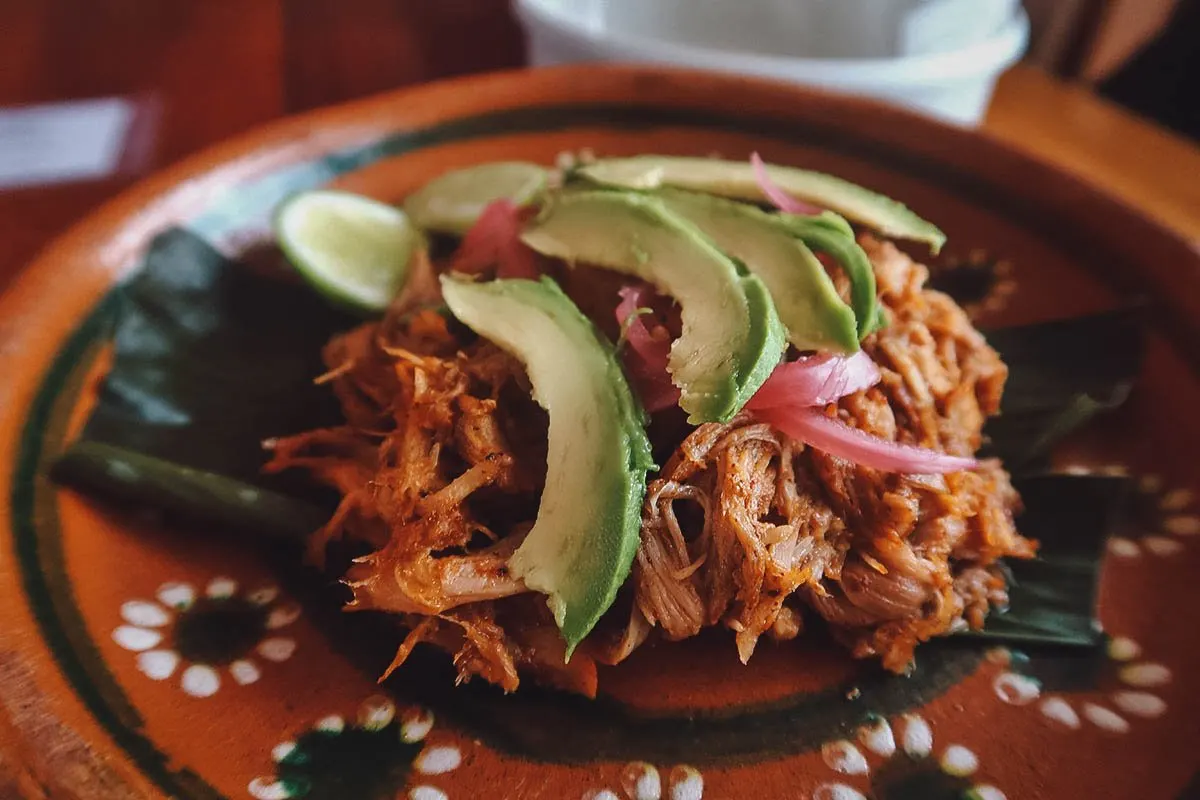
In the cochinita episode of Taco Chronicles, the producers were interviewing a young female traveler eating cochinita pibil tacos. According to her, she had been a vegetarian for over a year before arriving in Merida. She allowed herself to try cochinita pibil just once before resuming her journey to full-fledged vegetarianism. She ate her first cochinita pibil taco and never went back to being vegetarian again.
The cochinita pibil tacos pictured below were from the Merida restaurant featured on that episode. It was my first taste of cochinita at a Yucatan restaurant and it’s still one of my favorites.
Served on freshly made corn tortillas and topped with loads of pickled red onions, it was absolutely delicious. Go easy on the habanero salsa because it’s devilishly spicy.
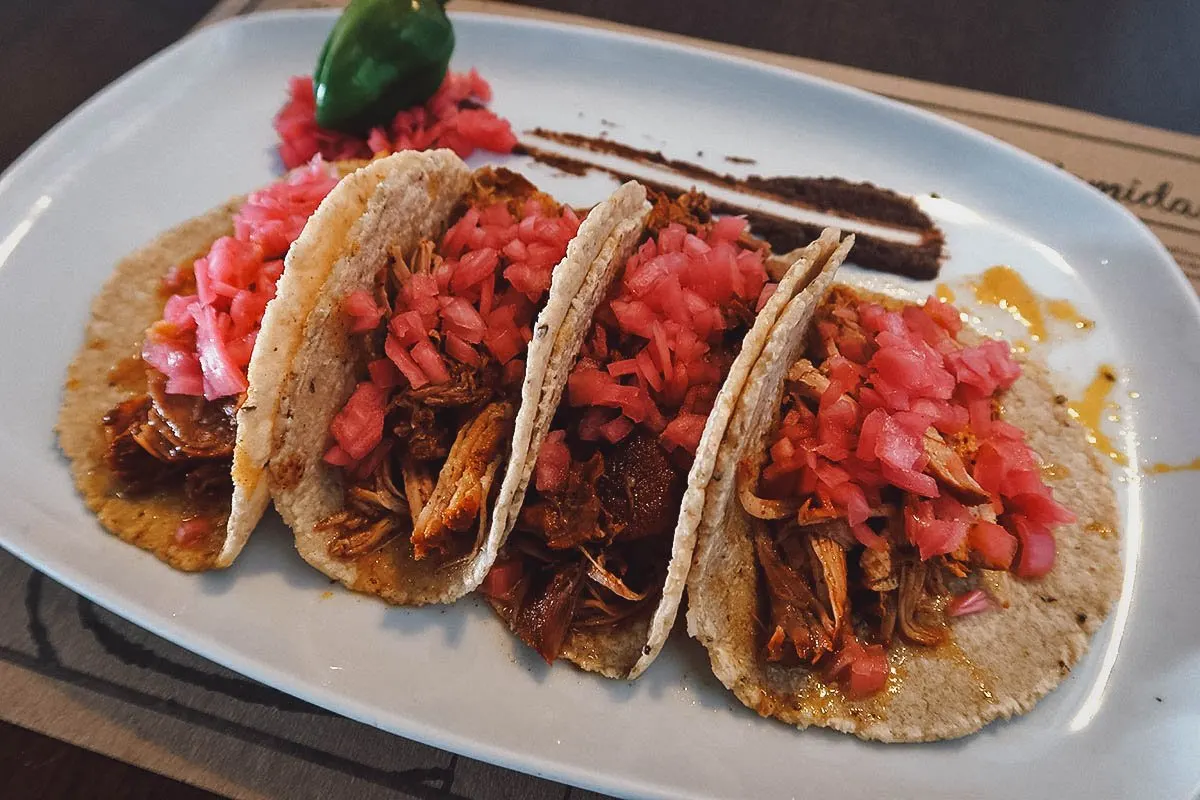
2. Poc Chuc
If cochinita sounds appealing to you, then you’ll definitely enjoy poc chuc. It’s another signature dish in Yucatan cuisine made with slow-roasted pork marinated in sour orange juice.
To prepare, a thin pork fillet is marinated in sour orange juice and then grilled over a wood or charcoal fire. In the Mayan language, poc means “to toast” over hot embers while chuc refers to “charcoal”. Like cochinita, this cooking method was devised as a way of preserving meat.
Poc chuc is typically served with fresh tortillas and a variety of side dishes like pickled red onions, avocado slices, sour orange wedges, chiltomate, and frijol con puerco. Chiltomate is a charcoal-roasted tomato salsa while frijol con puerco is a classic Yucatecan pork and beans stew.
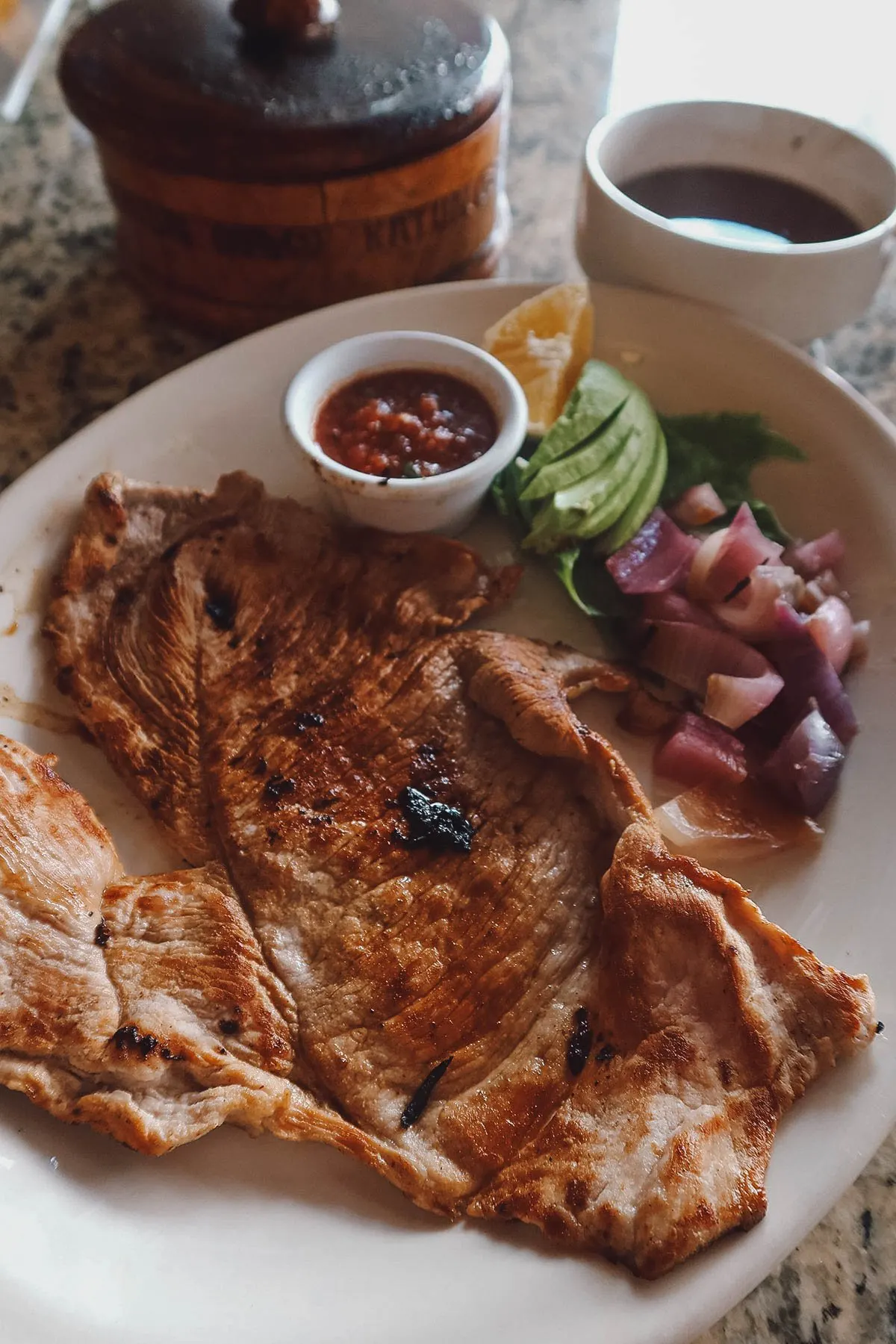
3. Castacan
Castacan refers to the Yucatecan version of crispy pork belly. It’s made from the stomach of the cerdo pelón or hairless pig, a Mexican breed that feeds exclusively on corn, cassava, pumpkin, and sweet potato.
To prepare, the pork belly is cut into small chunks with a thin piece of skin that gets crunchy when fried. It’s typically eaten in tacos with various accompaniments like pickled red onion, habanero pepper, and Oaxacan cheese.
Pictured below is a corn tortilla filled with tasty castacan meat and black beans. It’s from Wayan’e, one of the most popular taquerias in Merida.
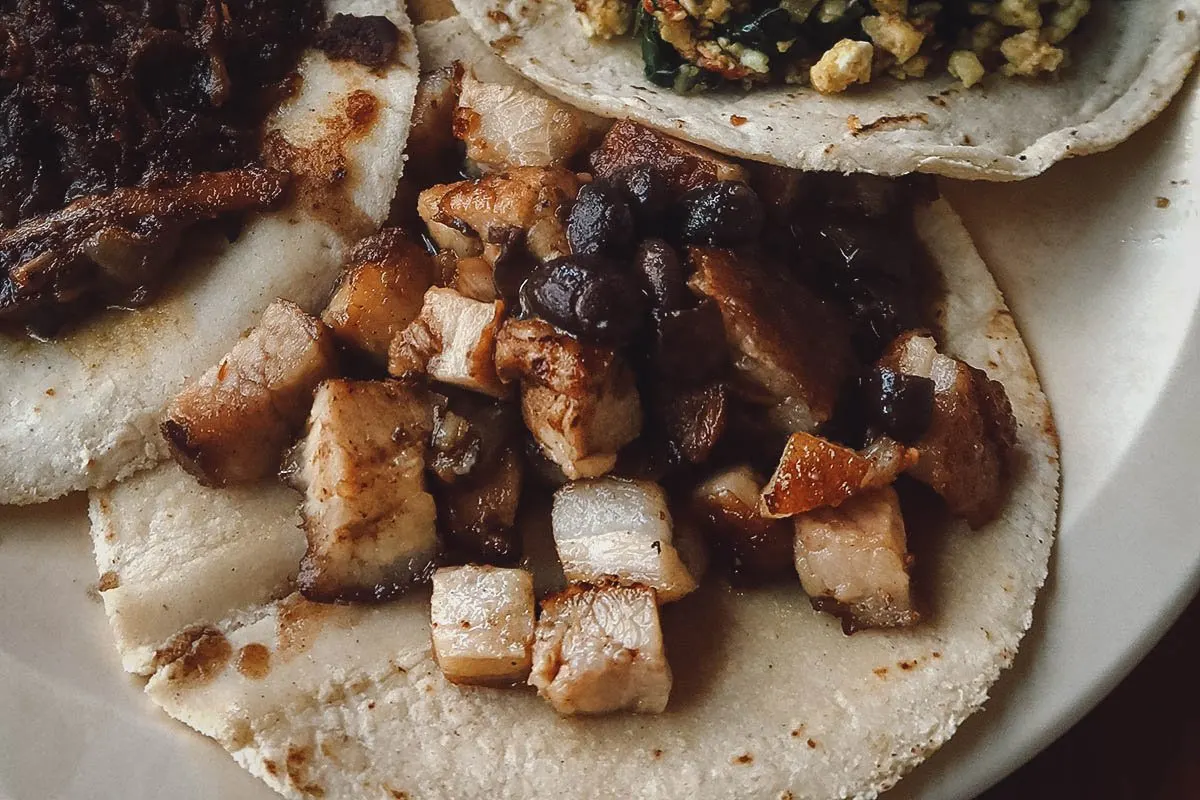
4. Lechon al Horno
As you can probably tell by now, pork features prominently in Mayan food. Lechon al horno literally means “baked suckling pig” and refers to a slow-roasted pork dish that’s been consumed for breakfast in the Yucatan since the time of the Spanish conquest.
Like cochinita, lechon al horno is traditionally wrapped in banana leaves and slow-cooked for many hours in a píib. The result is incredibly tender and succulent pork meat that’s typically eaten in tacos, tortas, salbutes, or panuchos, often with refried beans and xnipec, a spicy habanero pepper salsa.
Pictured below is lechon al horno served on a panucho with pickled red onion and a shard of crispy pork skin.
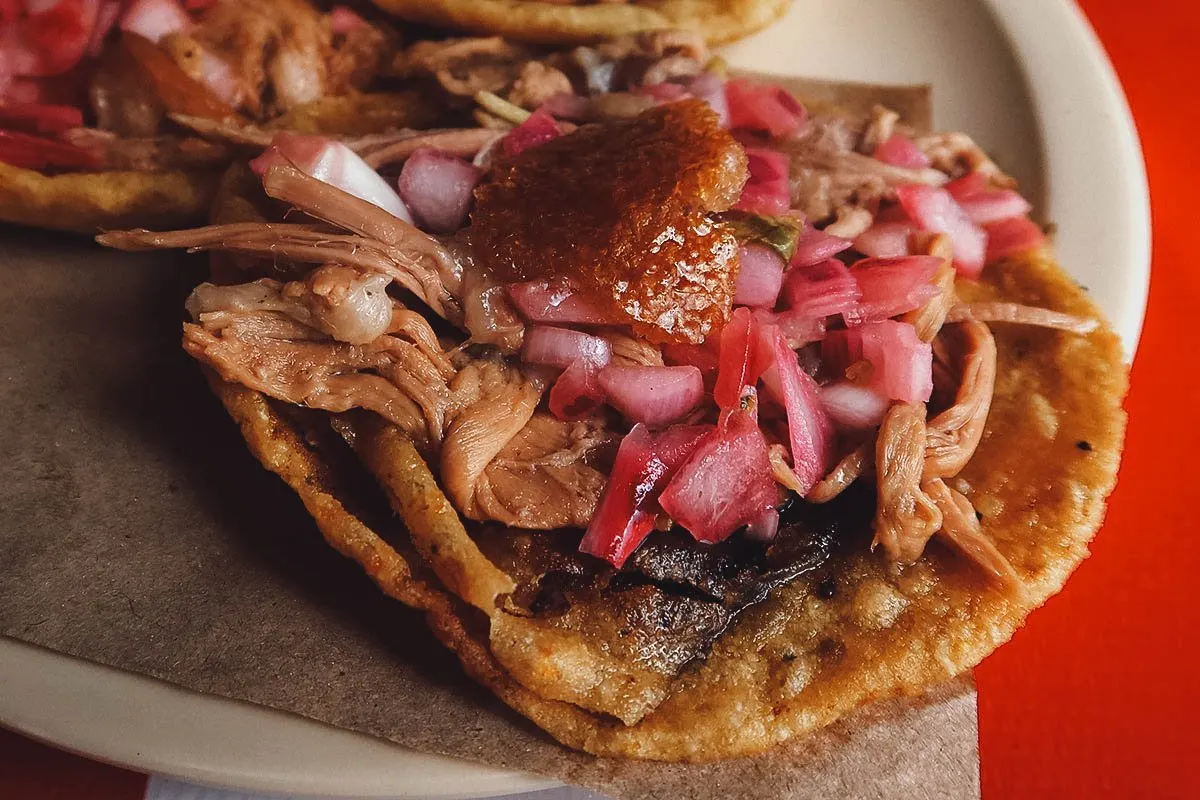
Here’s lechon al horno served on a salbut. Not every restaurant does this but the best lechon al horno salbutes I had were topped with a crisped-up piece of pork skin. Delicious!
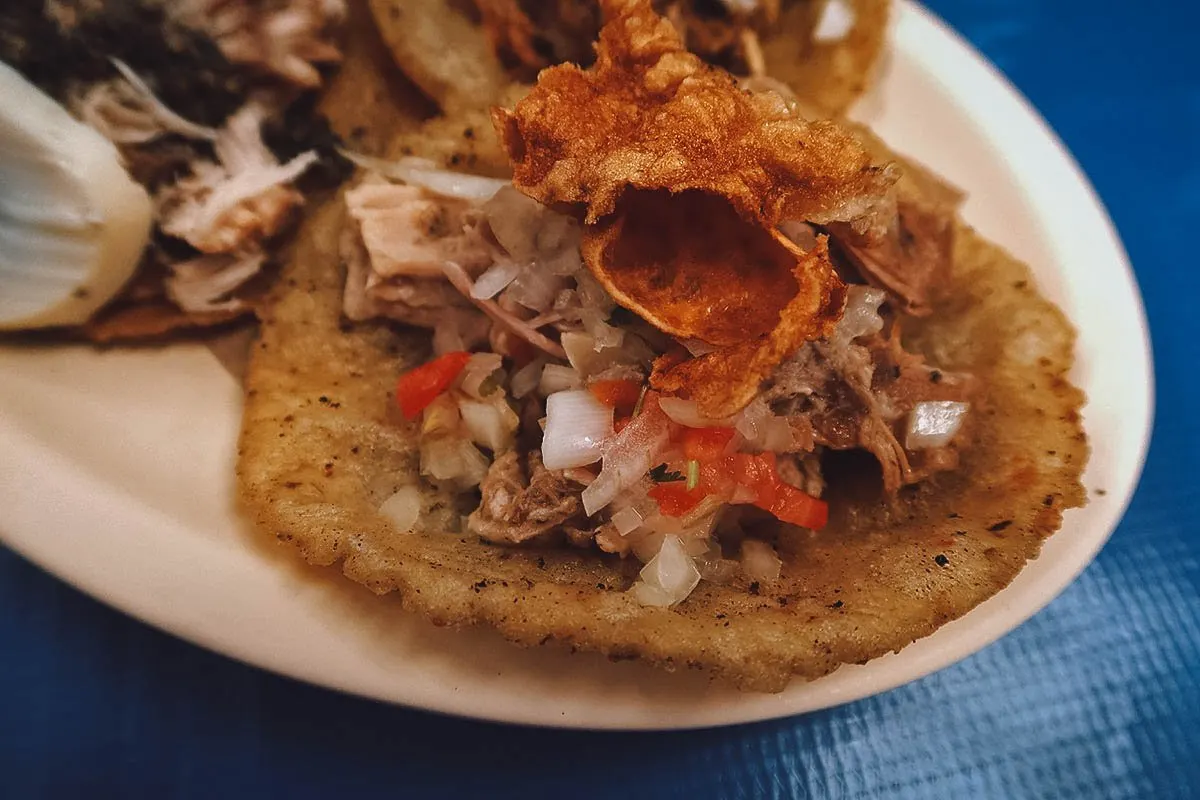
5. Lomitos de Valladolid
As its name suggests, lomitos de valladolid is a pork dish originally from the city of Valladolid. It consists of diced cubes of pork loin cooked in a slightly spicy tomato sauce. It’s typically served with hard-boiled eggs and different side dishes like corn tortillas, rice, avocado, salsa, and refried beans.
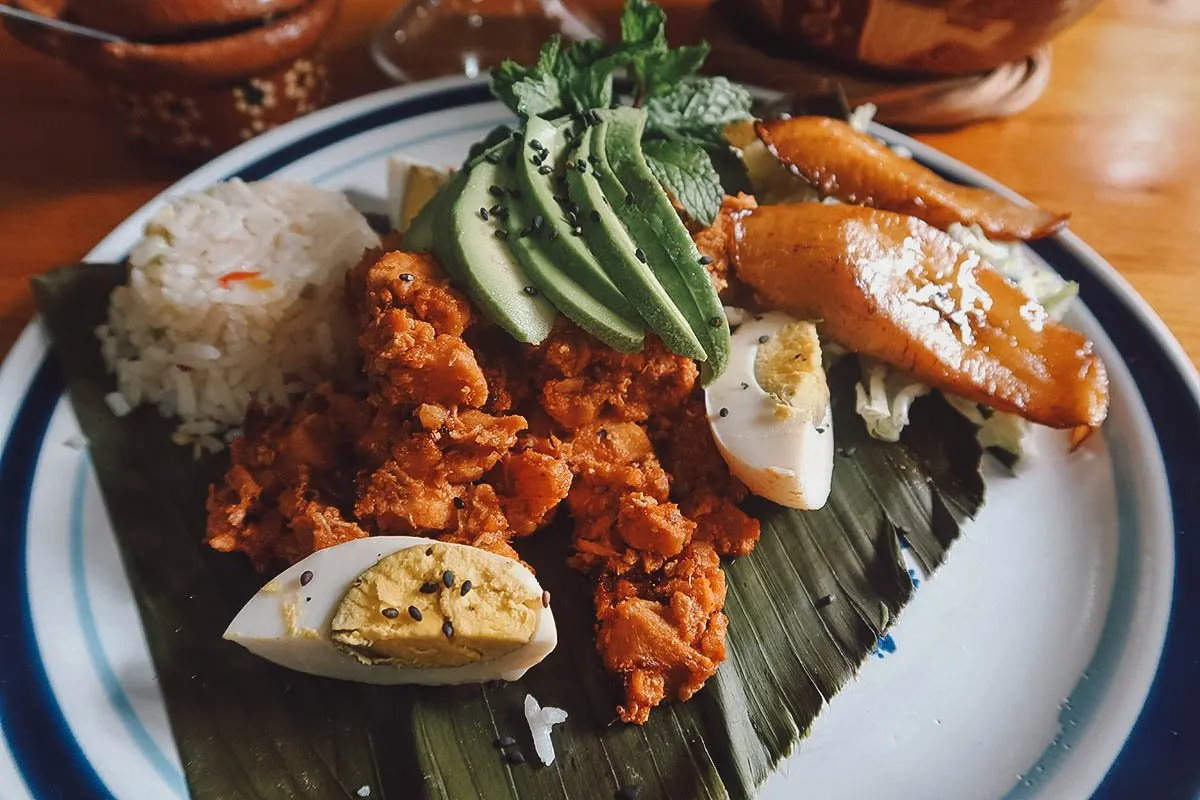
6. Longaniza de Valladolid
If you like sausages, then you need to try longaniza de valladolid. It’s a type of Yucatecan pork sausage seasoned with chile ancho, garlic, pepper, vinegar, and spices.
Longaniza de valladolid is served roasted with a variety of side dishes like pickled red onions, sour orange wedges, habanero pepper salsa, refried beans, and fried tortilla chips. When prepared well, the roasted sausage has a wonderfully crisp but crumbly texture that’s an absolute joy to eat. It’s delicious.
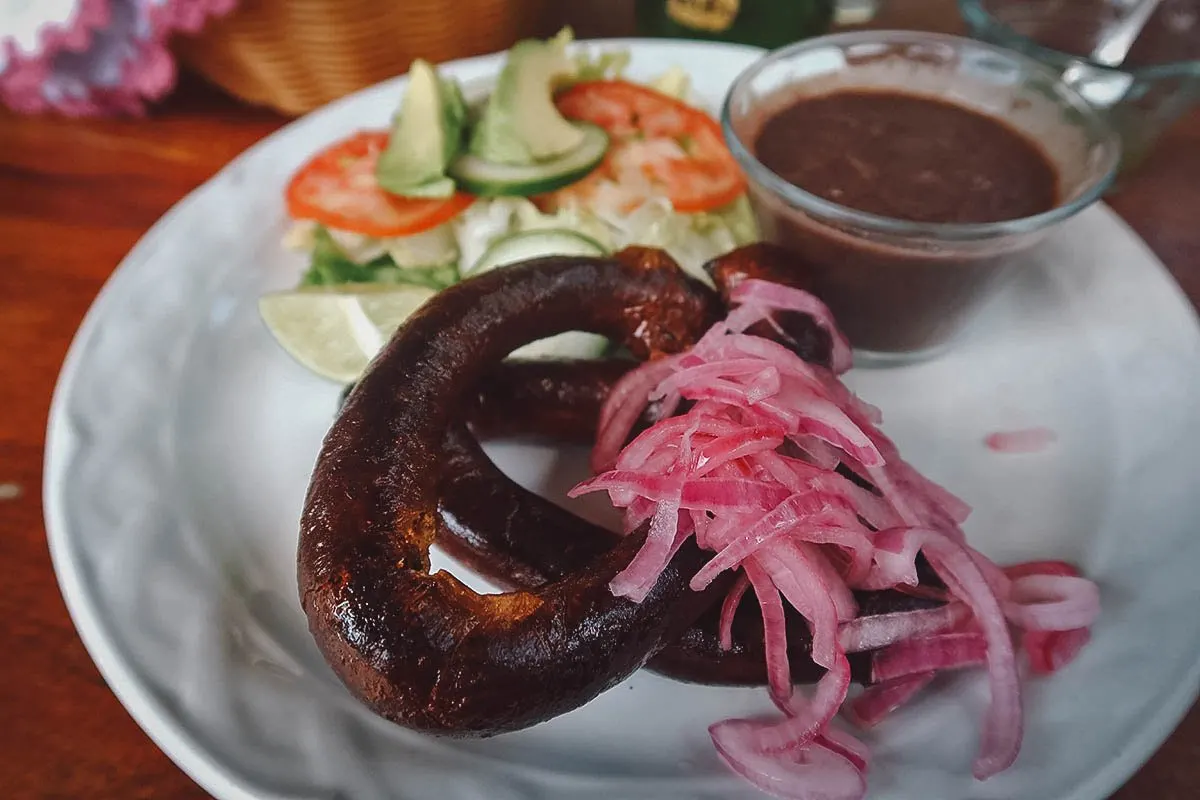
7. Higadilla
This is the only dish on this list of Yucatan foods that I didn’t personally try. I remember seeing it at Wayan’e but I didn’t order it because at the time, I didn’t know it was from the Yucatan Peninsula. Only after doing research for this article did I learn that it’s one of the less common specialties in Yucatecan cuisine.
Hígado in Spanish means “liver” so higadilla refers to a Yucatecan dish made with liver and other organ meats like the kidneys, heart, lungs, and tongue. The offal is meticulously cleaned and boiled with garlic, oregano, and seasonings before being chopped into cubes and flavored with sour orange juice and achiote.
8. Relleno Negro
Pavo en relleno negro – or simply relleno negro – refers to a popular Yucatecan dish made with turkey meat and ground pork swimming in a thick dark sauce. The jet-black sauce may be off-putting for some, but like mole negro or mole poblano, relleno negro gets its color mainly from roasted chili peppers (chile ancho).
Relleno negro is one of the oldest recipes in Yucatecan regional cuisine. Like many Mexican sauces, it’s made with a laundry list of ingredients like sour orange juice, achiote, tomatoes, epazote, burnt tortillas, garlic, and spices. It can be eaten on its own with chopped boiled eggs or served as a topping on salbutes and panuchos.
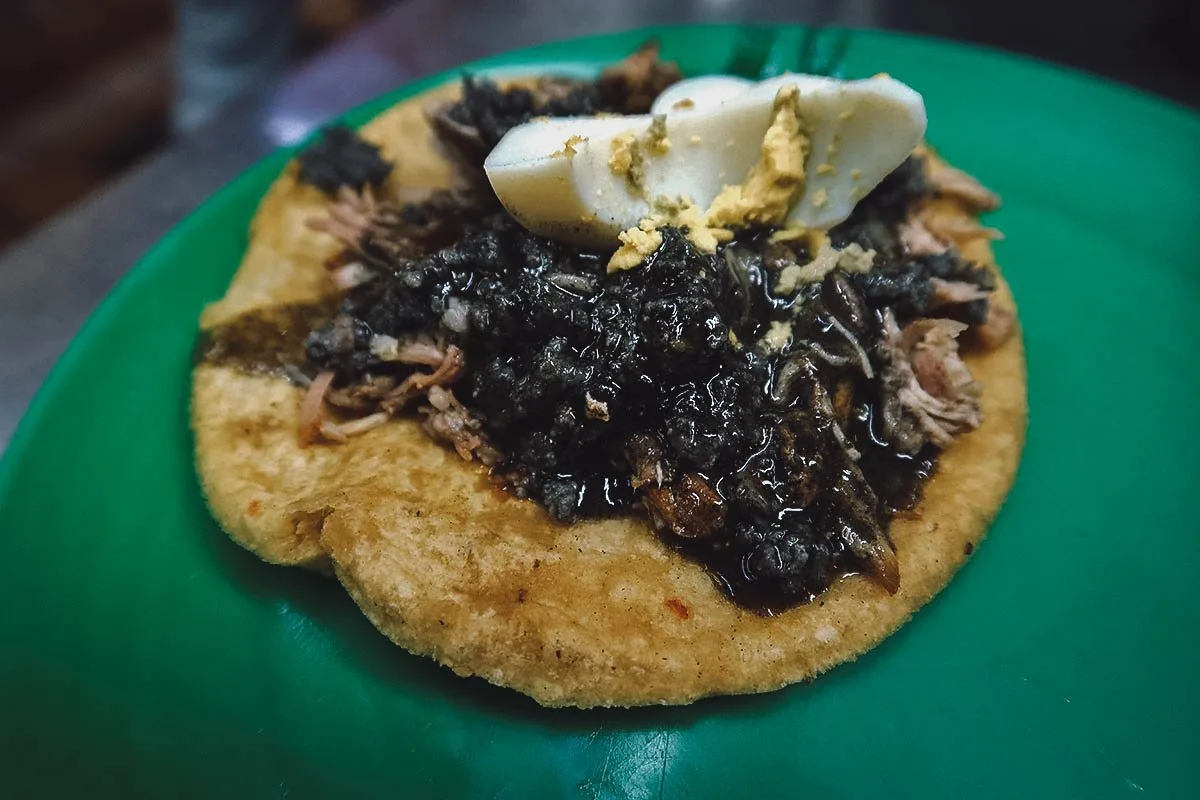
I didn’t see this nearly as often as relleno negro. In fact, I spotted it just once on a restaurant’s menu in Merida.
What you’re looking at is relleno blanco, a similar turkey and ground pork dish swimming in a white sauce called k’ool. The white sauce is made by adding saffron and wheat flour to the same water used to boil the turkey.
Relleno blanco is served by pouring the white sauce over the turkey and ground pork, and then finishing it with some tomato sauce.
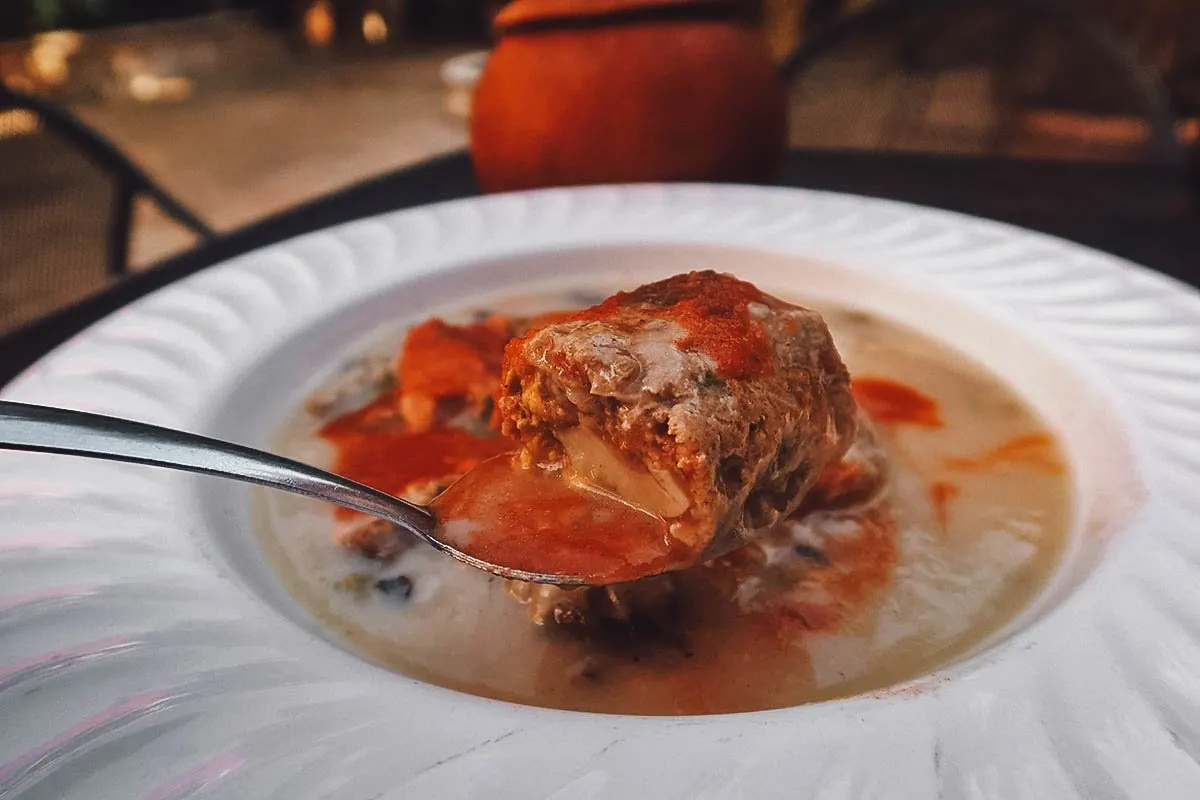
9. Salbutes
Salbutes and panuchos are among the most common antojitos or snacks you’ll find anywhere on the Yucatan Peninsula. A salbut is basically a deep-fried tortilla topped with any number of ingredients like cochinita, relleno negro, lechon al horno, lomitos, carne asada, and seafood. Like tacos, you can basically top them with anything.
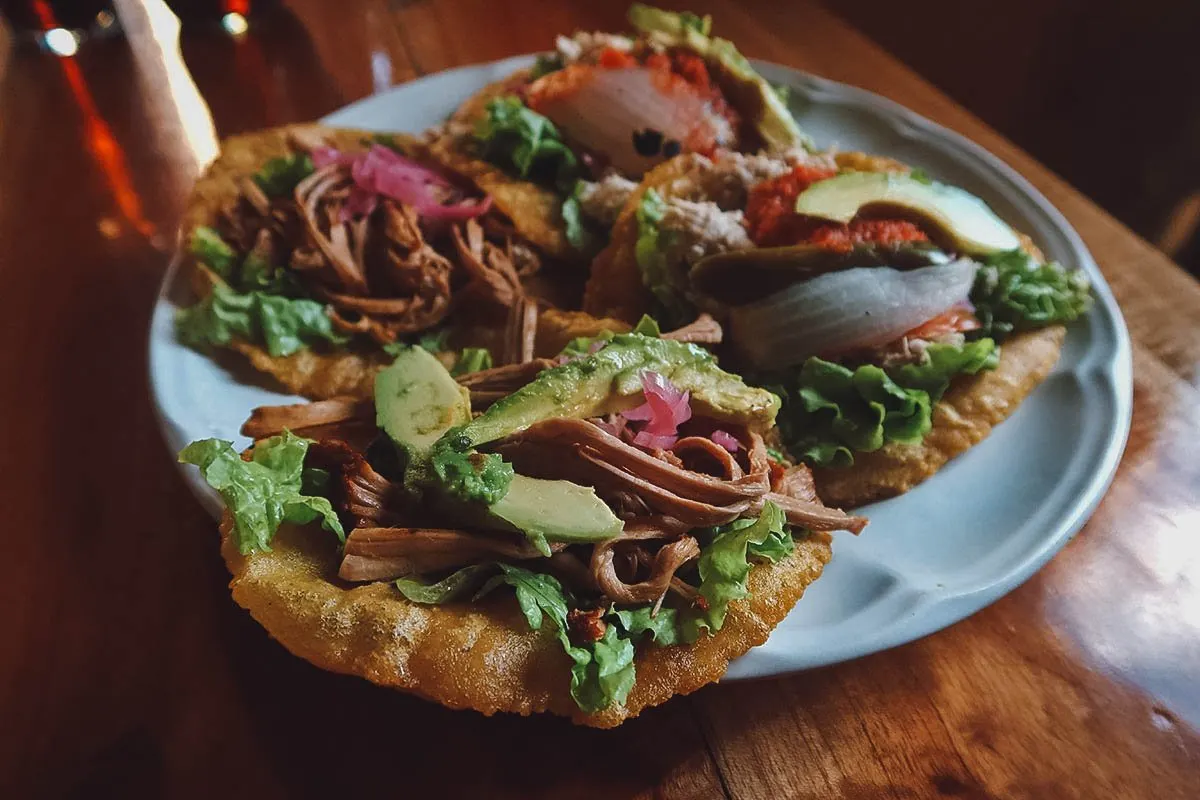
10. Panuchos
Panuchos are almost the same thing as salbutes except they’re made with corn dough stuffed with refried black beans. Like salbutes, they can be topped with anything.
Salbutes and panuchos look almost identical but you can easily tell the difference when you take a bite. While a salbut is soft, like a puffy fried tortilla, a panucho is a little harder and crunchier in texture. They’re both good but personally, I prefer salbutes.
On the plate below are two salbutes and one panucho. Can you tell which is which?
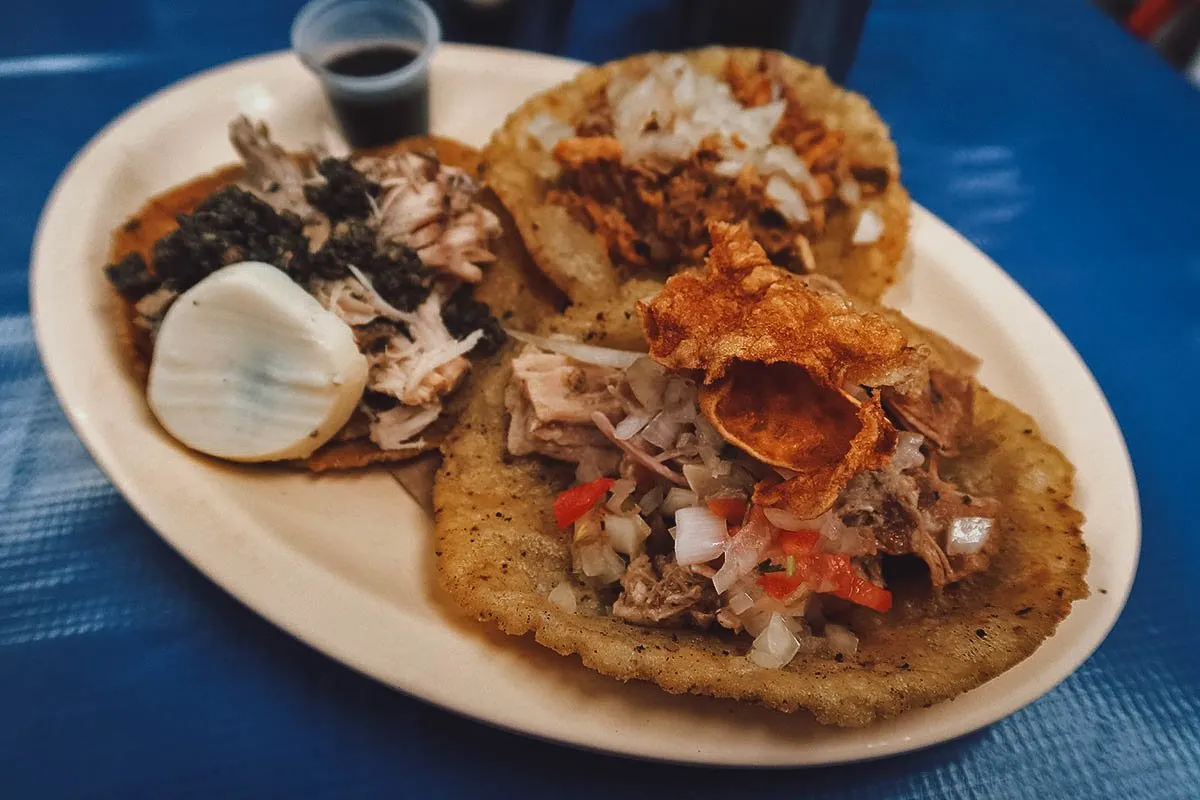
11. Pibihuajes
I was standing outside a busy food stall inside a market in Valladolid when I noticed nearly every customer eating these grenade-sized ovals of food. They looked similar to kibis and were stuffed with the same ingredients normally used as toppings for salbutes or panuchos.
I asked the server what it was and he told me they’re called pibihuajes. I googled them and as it turns out, they’re a specialty dish of Valladolid. According to the origin story, cochinita vendors asked chachachuajes sellers (similar to tamales) to make them so they could stuff them with their cochinita. People enjoyed them and the rest is history.
Pibihuajes are basically football-shaped spheres of bread made with dough and red beans. They’re baked in a píib before being split open and filled with different ingredients like cochinita, lomitos, and lechon al horno. They’re very firm and dense in texture – less like a bread and more like mashed plantains.
Unlike salbutes and panuchos, pibihuajes don’t seem to be as common in other parts of the Yucatan Peninsula so you should definitely try them when you visit Valladolid.
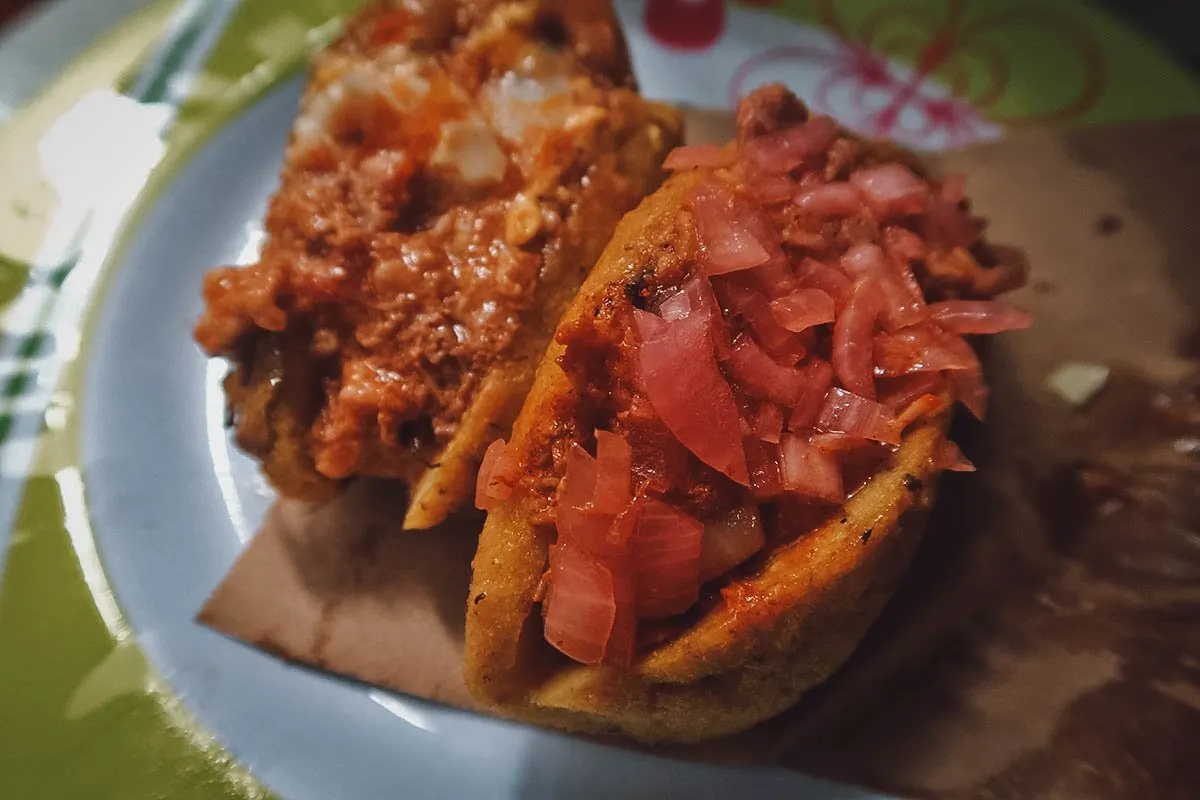
12. Kibis
The taco al pastor is probably the most well-known dish derived from Lebanese influence on Mexican food. Kibis is another.
People familiar with Lebanese food will recognize kibis as the Mexican version of kibbeh, a meatball-like Lebanese dish made with spiced ground meat, pine nuts, onions, and bulgur wheat.
Kibis is made in a similar way as kibbeh but it differs in spices used and how it’s eaten. Being a Yucatecan dish, kibis recipes include sour orange juice and habanero chili peppers. It can also be split lengthwise and filled with various ingredients like red onion, chopped cabbage, ground beef, and queso de bola (Edam cheese).
Kibis is a popular appetizer or street snack sold throughout the Yucatan, often in glass boxes by street vendors. You can also find them at cantinas or peddled along the beach.
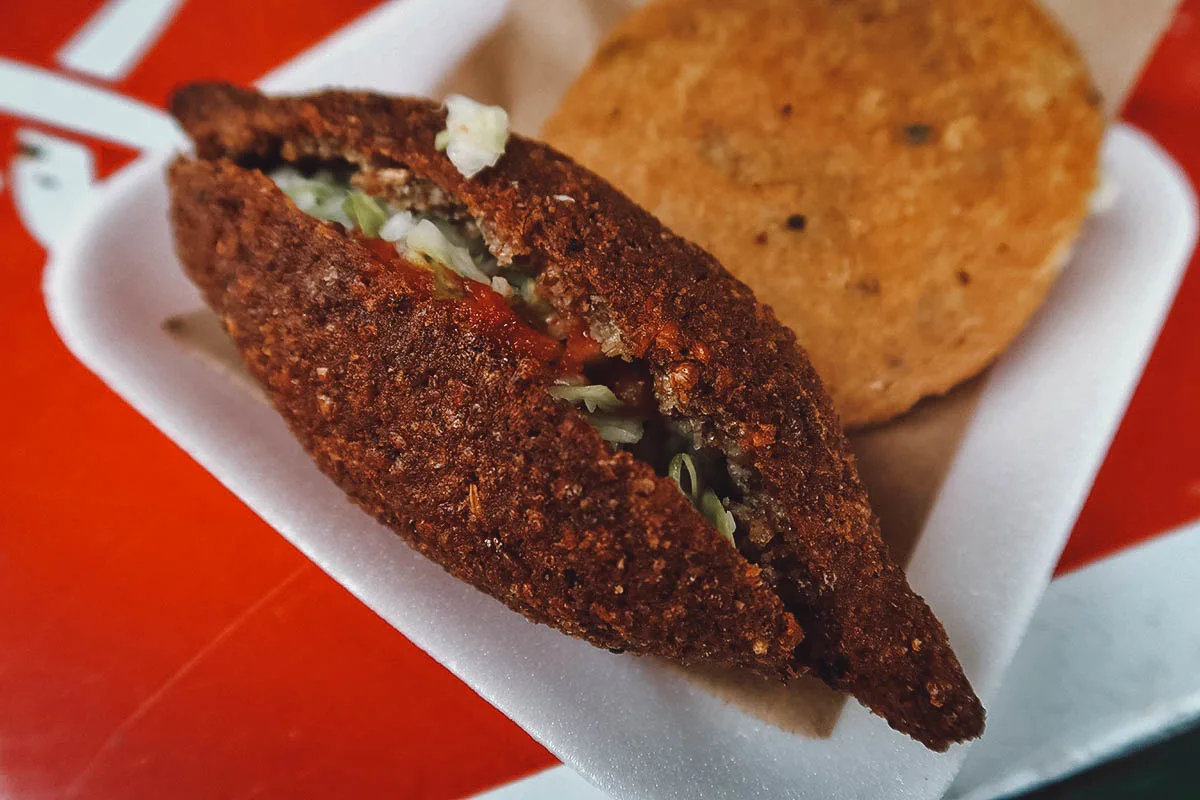
13. Polcanes
Polcanes are a pre-Hispanic dish commonly eaten as an appetizer or street snack in the Yucatan. They’re deep-fried patties made from masa stuffed with a mixture of ibes (Yucatecan white beans), pepitas (pumpkin seeds), chives, and ground chili pepper.
Polcanes are typically eaten with a side of red onions, cabbage, tomato sauce, and cheese. In some cases, they can also be split open and stuffed with the ingredients.
The name polcan comes from the Mayan words pol and can, meaning “head” and “snake”. They used to be more oval in shape, like the head of a snake, but nowadays, they’re typically round and resemble gorditas.
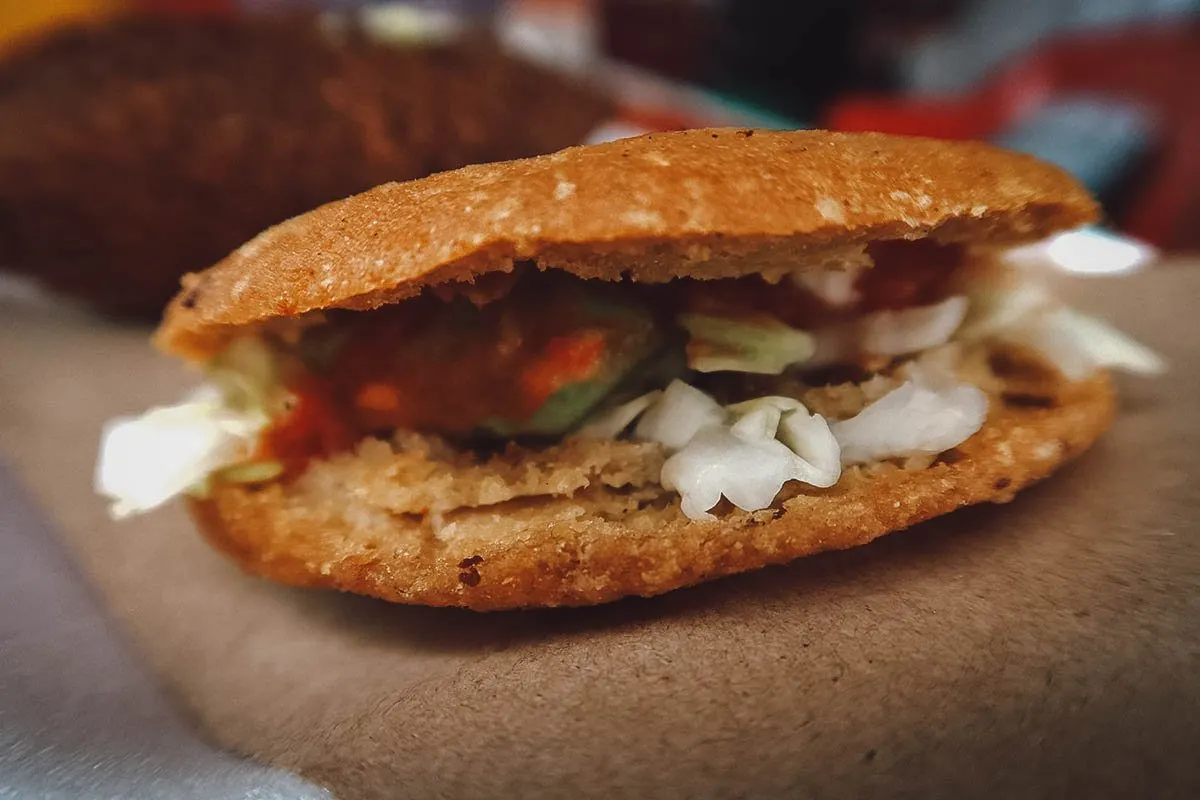
14. Papadzules
Papadzules are another Yucatecan dish with ancient roots. They resemble enchiladas and consist of stuffed corn tortillas drenched in two sauces – one made from pepitas (pumpkin seeds) and the other a tomato sauce.
If you’re a vegetarian, then you’ll definitely want to try papadzules. The dish contains no meat and is stuffed only with coarsely-chopped hard-boiled eggs. Because of its appearance, some speculate that papadzules may be the forerunner to modern enchiladas.
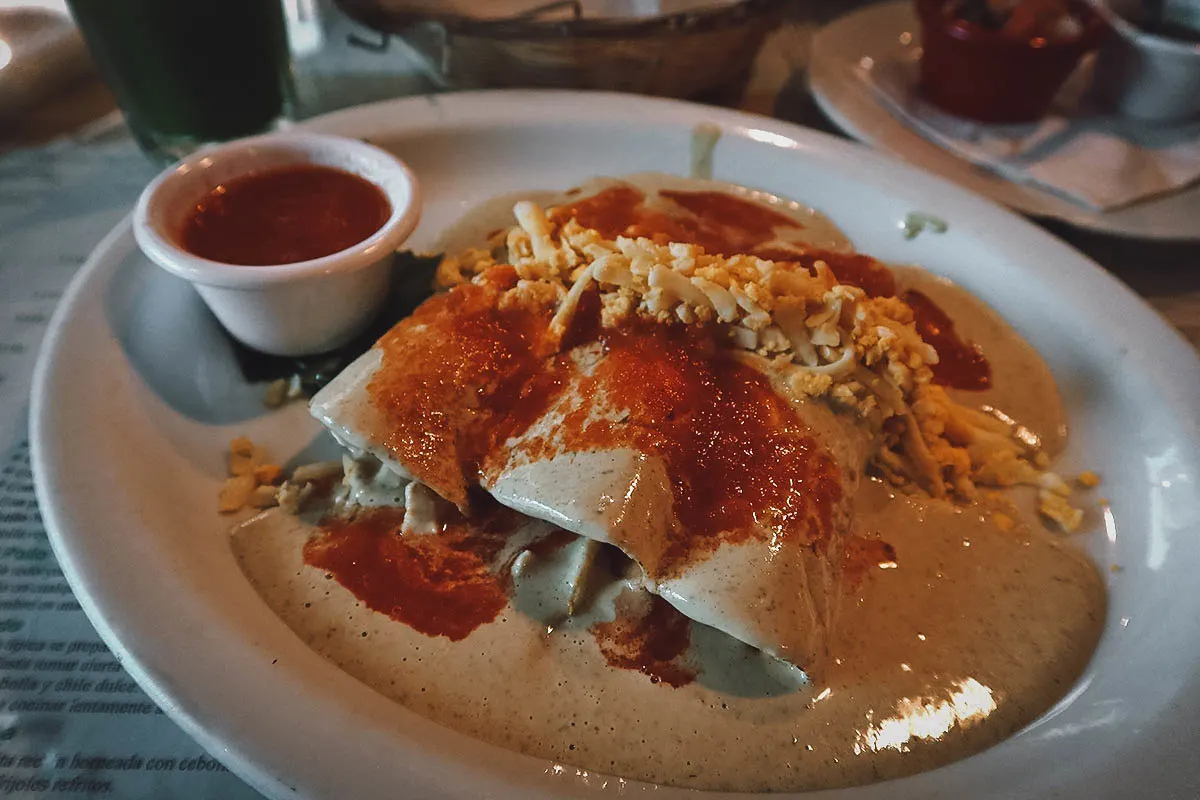
15. Sopa de Lima (Yucatecan soup with fried tortilla strips)
Like salbutes, panuchos, and cochinita, sopa de lima is one of the most popular dishes in Yucatan cuisine. Meaning “lime soup”, sopa de lima refers to a type of Yucatecan soup made with shredded chicken or turkey meat served in a broth with fried tortilla strips.
As you can probably guess, sopa de lima is known for its citrusy flavor derived from lime juice. Depending on the cook, it can be made with other ingredients as well like tomatoes, bell peppers, avocado, and cilantro. It’s a flavorful and filling soup that can be enjoyed as a full meal.
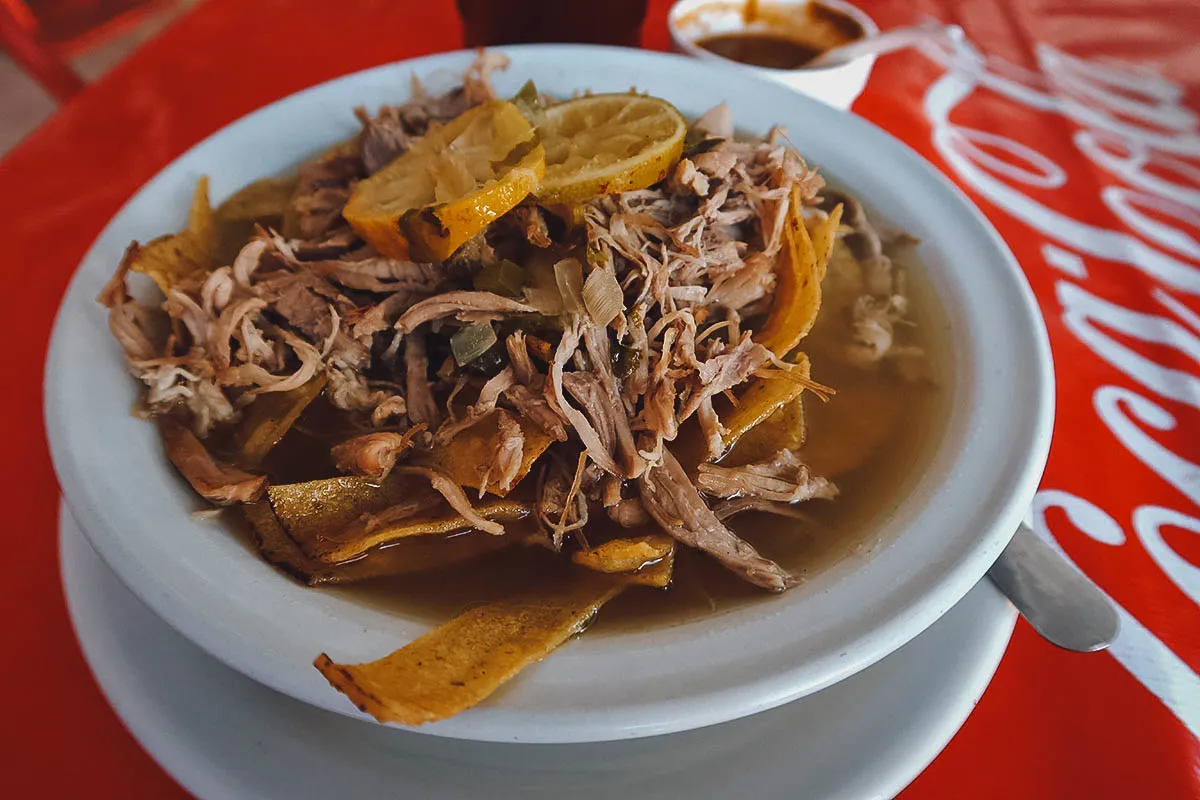
16. Queso Relleno
Like kibis, queso relleno is one of the most well-known examples of delicious fusion foods in the Yucatan Peninsula, this time Mexican and Dutch.
Queso relleno is a Yucatecan dish made with a queso de bola rind (Edam cheese) stuffed with a filling of spiced minced pork, ground beef, raisins, nuts, spices, and other ingredients. The stuffed rind is steamed to lightly melt the cheese before being drenched in k’ool and topped with tomato sauce.
No one really knows how, but Dutch Edam cheese became a common food item in the Yucatan. Wealthy hacienda owners would eat the creamy insides and discard the tougher rinds. Servants would save, stuff, and steam the rinds, giving rise to queso relleno.
I was particularly interested in this dish because queso de bola is popular in our native Philippines as well, especially as a Christmas food. As you can imagine, queso relleno is a filling dish so don’t expect to have room for anything else if you order this.
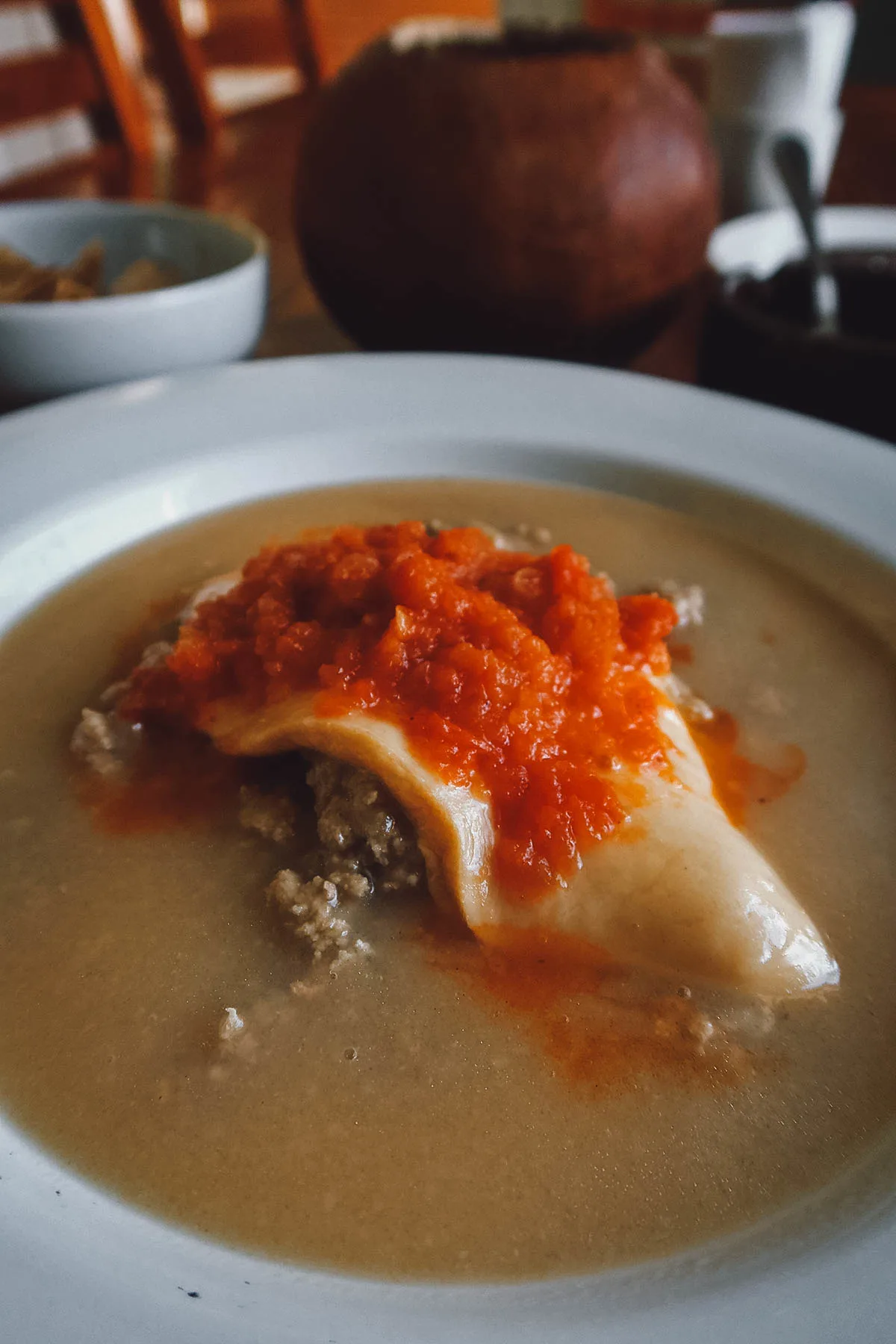
17. Huevos Motuleños
Huevos motuleños is one of the most popular dishes in this Yucatan food guide. We enjoyed it for breakfast all throughout Mexico without realizing that it’s originally from the Yucatan town of Motul, about 44 km (27.3 miles) east of Merida.
Huevos motuleños is a popular breakfast dish consisting of corn tortillas topped with black beans, fried eggs, cheese, and tomato sauce. Depending on the cook, it can be made with other ingredients as well like diced ham, peas, and fried plantains.
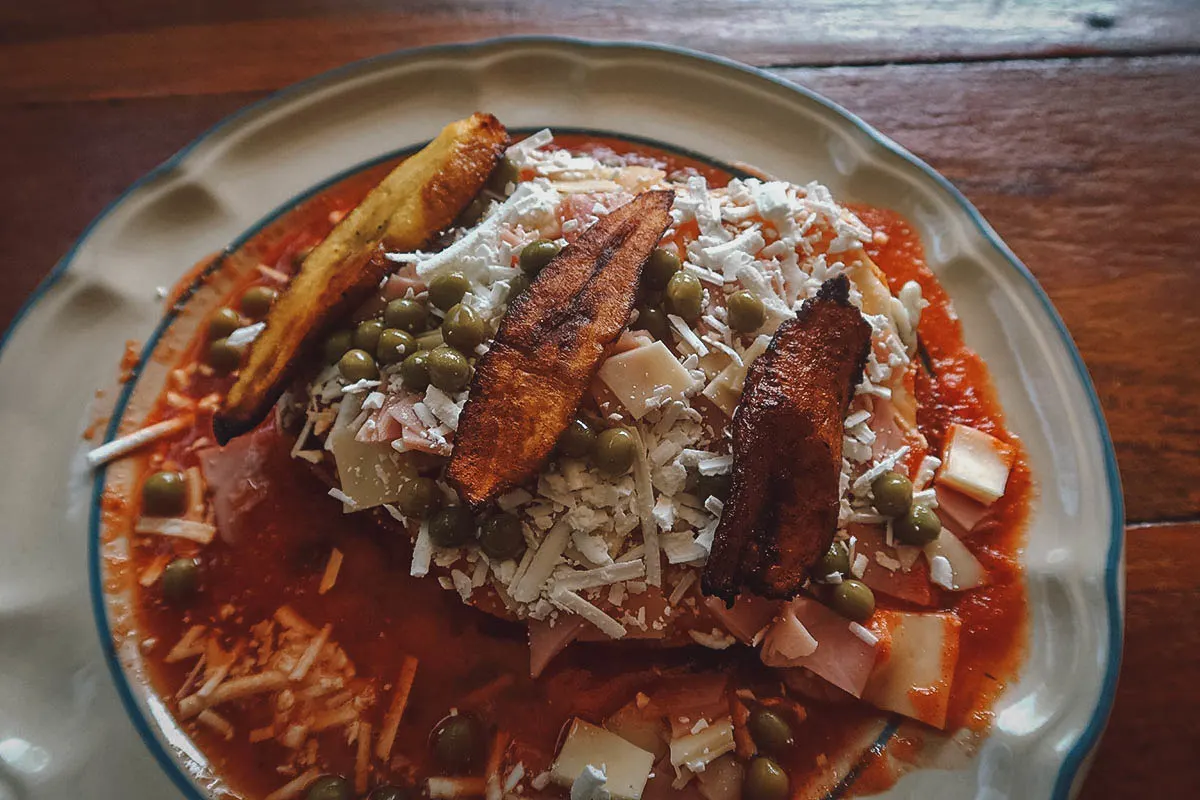
18. Pollo en Escabeche Oriental
The term escabeche refers to a cooking method popular in Latin America, Spain, Portugal, and the Philippines. It consists of marinated meats, fish, poultry, or vegetables cooked in an acidic sauce, usually with vinegar.
Pollo en escabeche oriental refers to a specific type of Yucatecan escabeche made with chicken (or turkey meat). The chicken is marinated in a mixture of vinegar, garlic, coriander, cumin, cloves, cinnamon, and seasonings before being boiled in water with chopped red onions and sour orange juice. The chicken is then cooked on a grill and served in a broth with onions and chili peppers.
This version of Yucatecan escabeche is called “oriental” because it hails from the eastern part of the Yucatan Peninsula, specifically Valladolid.
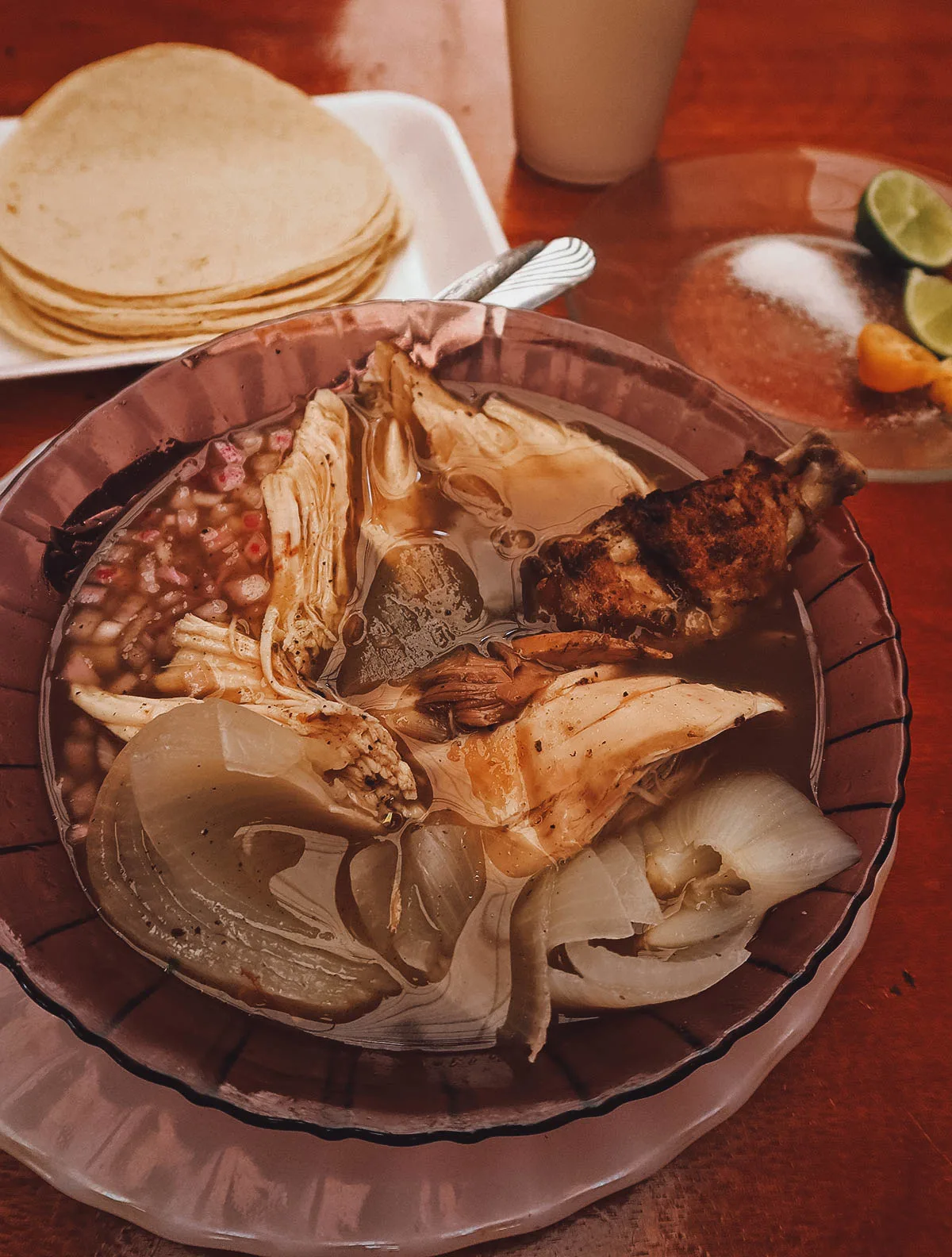
19. Tamales Colados
If you like Mexican tamales, then you need to try tamales colados. In her book The Art of Mexican Cooking, British food writer and Mexican food expert Diana Kennedy describes this elaborate form of tamale as “the highest form of tamale-making” in Mexico.
What makes tamales colados so special is that the masa corn dough is strained, giving it a silky soft and extra smooth texture. It’s then mixed with a gravy filling and wrapped in banana leaves before being steamed for hours. This creates a tamale that’s softer and more delicate than any other in Mexico.
Tamales colados are served in banana leaf and topped with tomato sauce. In some cases, it can also be topped with shredded chicken.
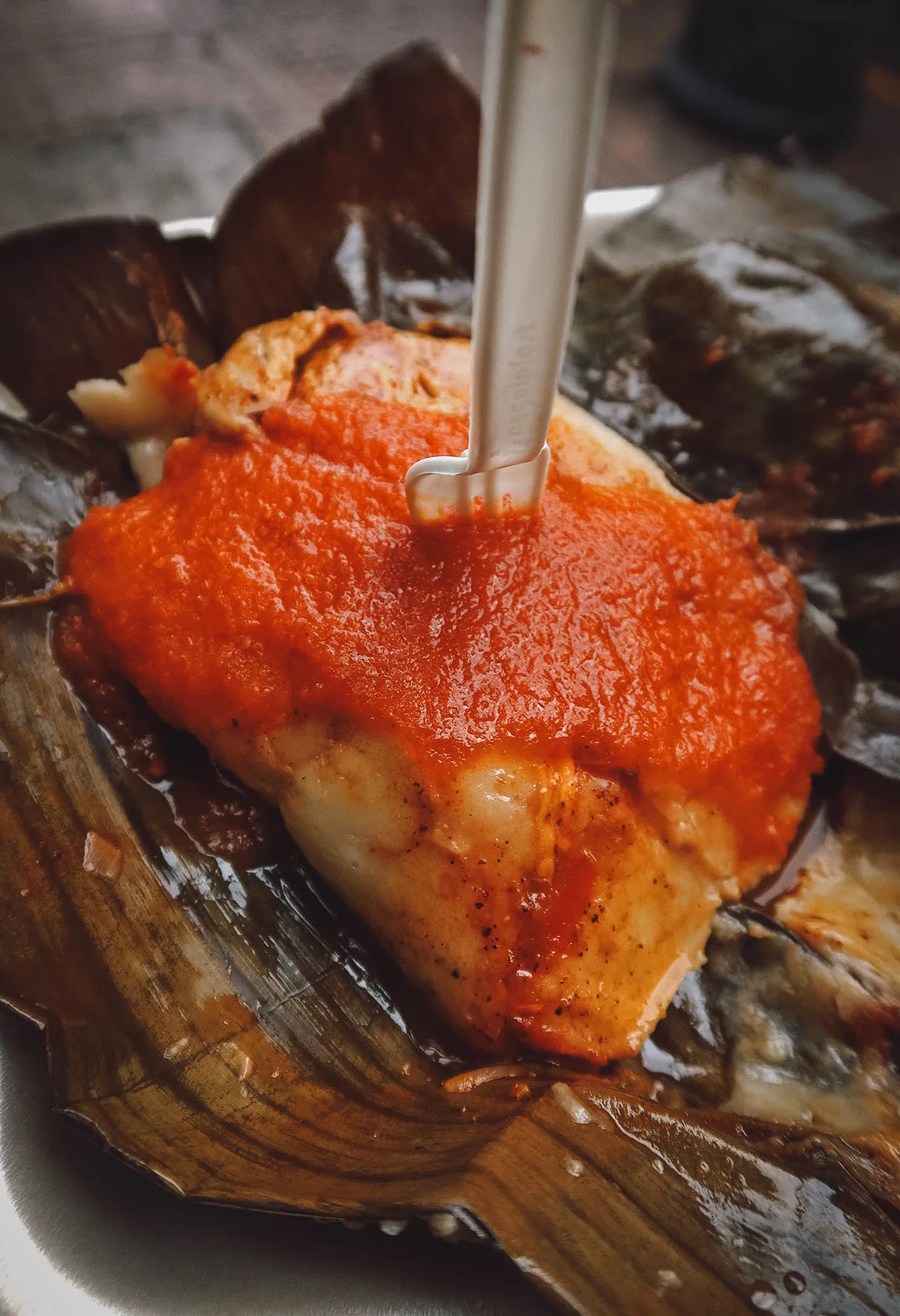
20. Marquesitas
Marquesitas are among the most common street foods you’ll find in the Yucatan. Typically sold from street food carts at night, they consist of a rolled-up crunchy crepe filled with a variety of ingredients like cajeta (dulce de leche), jam, fruits, and chocolate. One of the most common versions is filled with Nutella and Edam cheese.
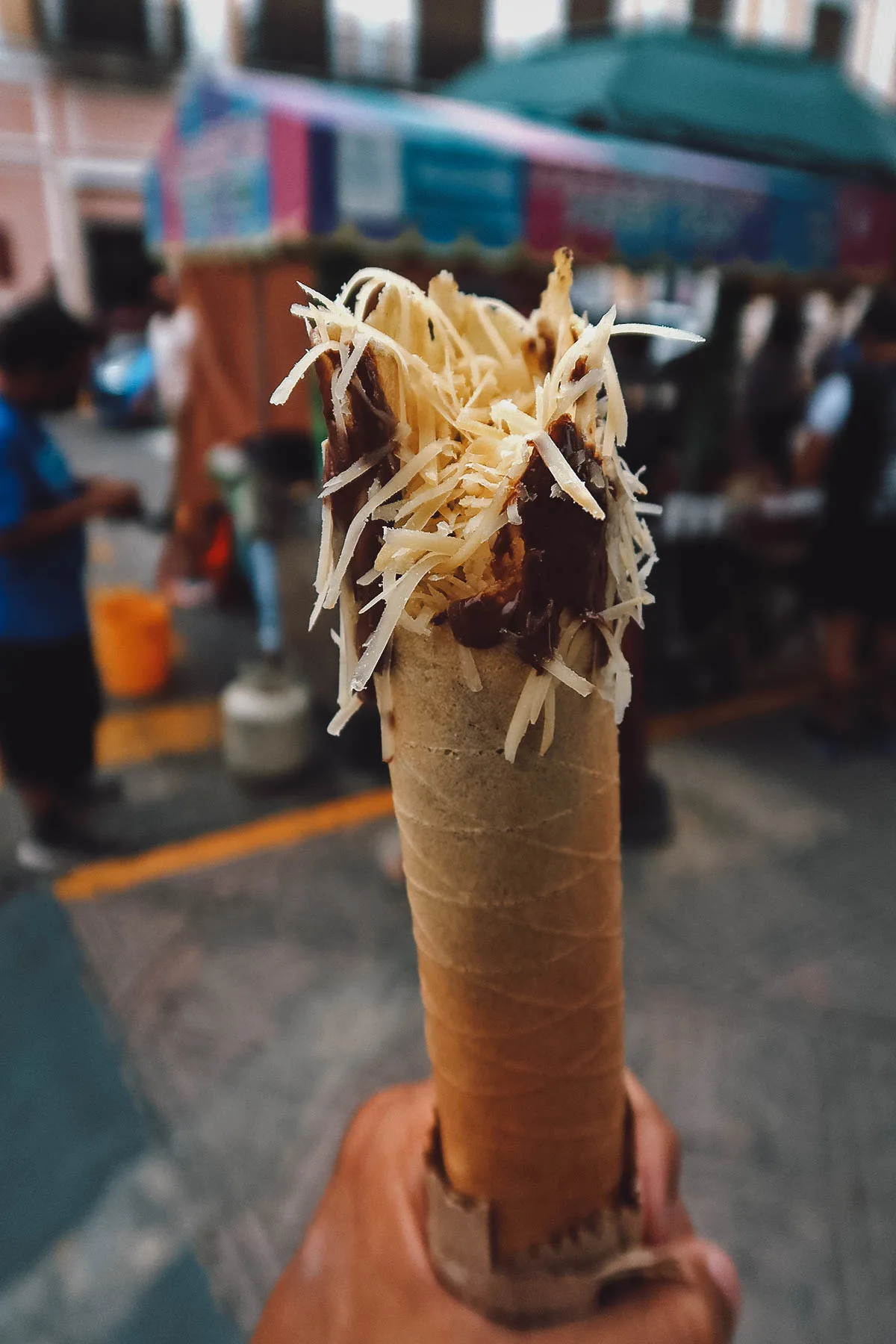
21. Dulce de Papaya
Dulce de papaya is a simple Yucatecan dessert of unripe papaya cooked at low heat with sugar, cinnamon, vanilla, and water. It’s sweet and firm in texture when cooked and usually served with small cubes or shreds of grated Edam cheese.
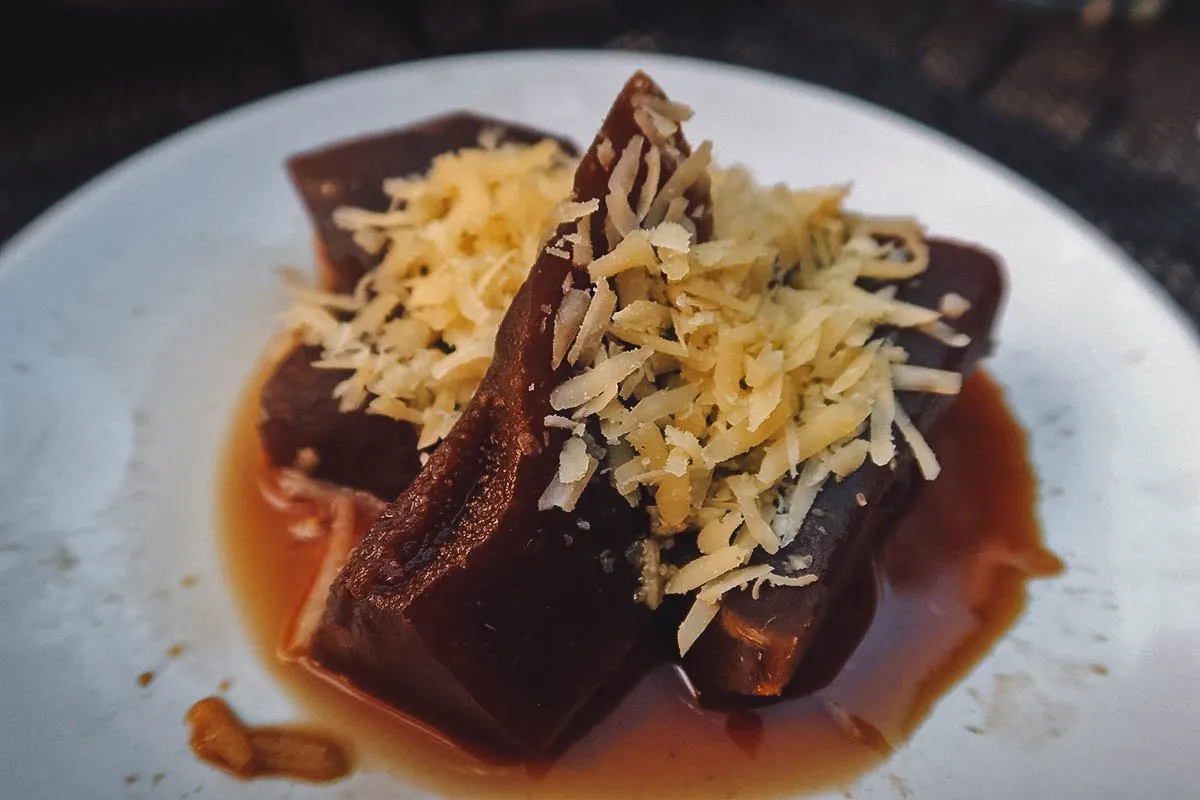
22. Caballero Pobre
Caballero pobre is basically the Yucatecan version of French toast. Enjoyed as a snack or for dessert, it’s very similar to Spanish torrijas or Portuguese/Brazilian rabanadas, but with its own unique twist.
To prepare, slices of bread are dipped in a mixture of milk, vanilla, and sugar. What makes caballero pobre unique is that the bread is coated in a second mixture made with egg whites that are beaten till stiff and then mixed with beaten egg yolks.
The coated slices of bread are then fried in oil and served with syrup, raisins, almond slivers, and slices of fruit.
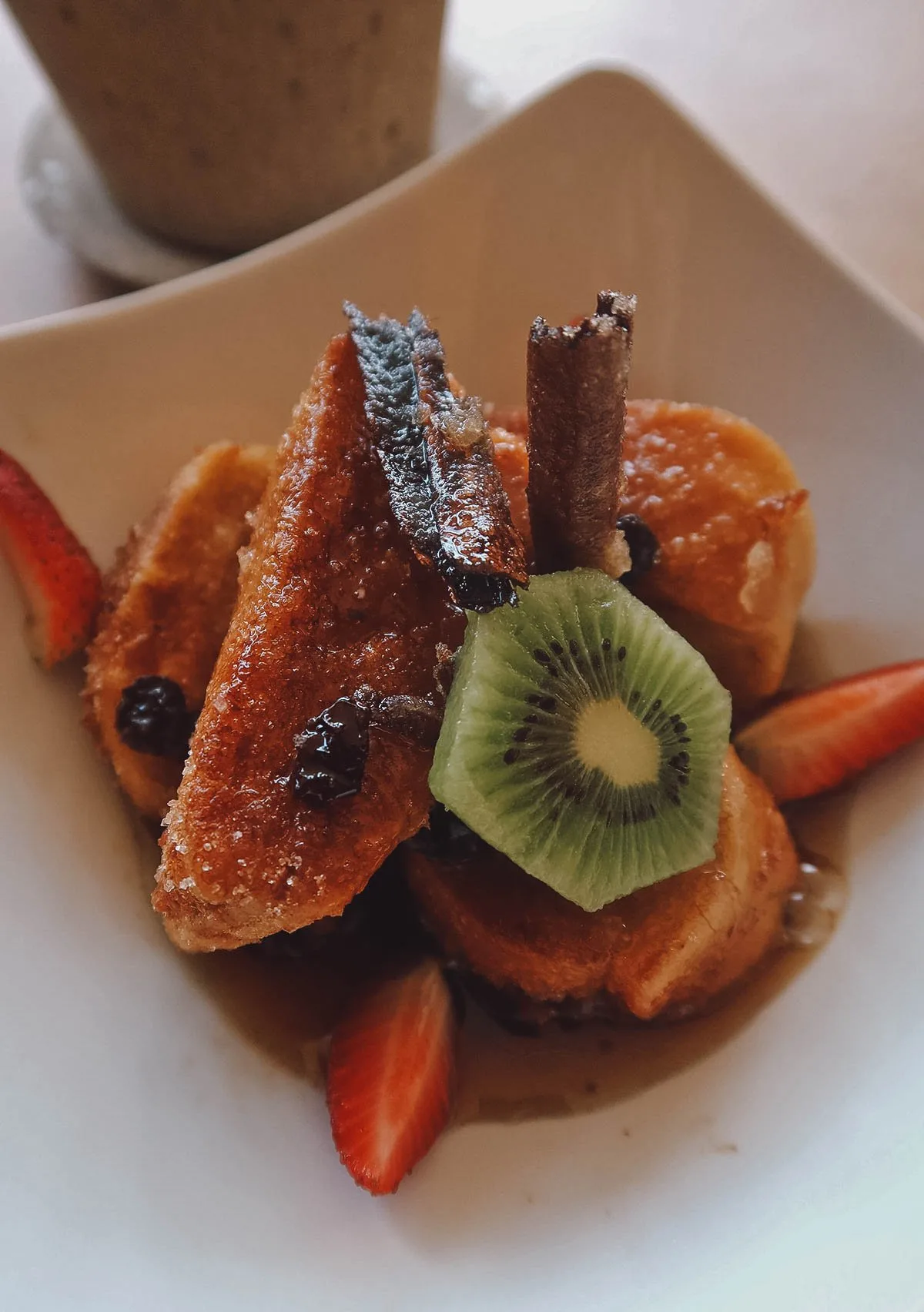
23. Champola
As described, it can get brutally hot in the Yucatan Peninsula. This is why refreshing desserts and drinks like champola are a godsend in this part of Mexico.
Champola is a popular dessert in the states of Yucatan, Campeche, and Quintana Roo. It’s basically a Yucatecan milkshake enriched with pureed whole fruit like strawberry, mango, mamey, and soursop.
I asked my server for the most traditional version and he recommended I get the coconut. After drinking this, I felt like I had just gone swimming in a cenote. It was so damn refreshing.
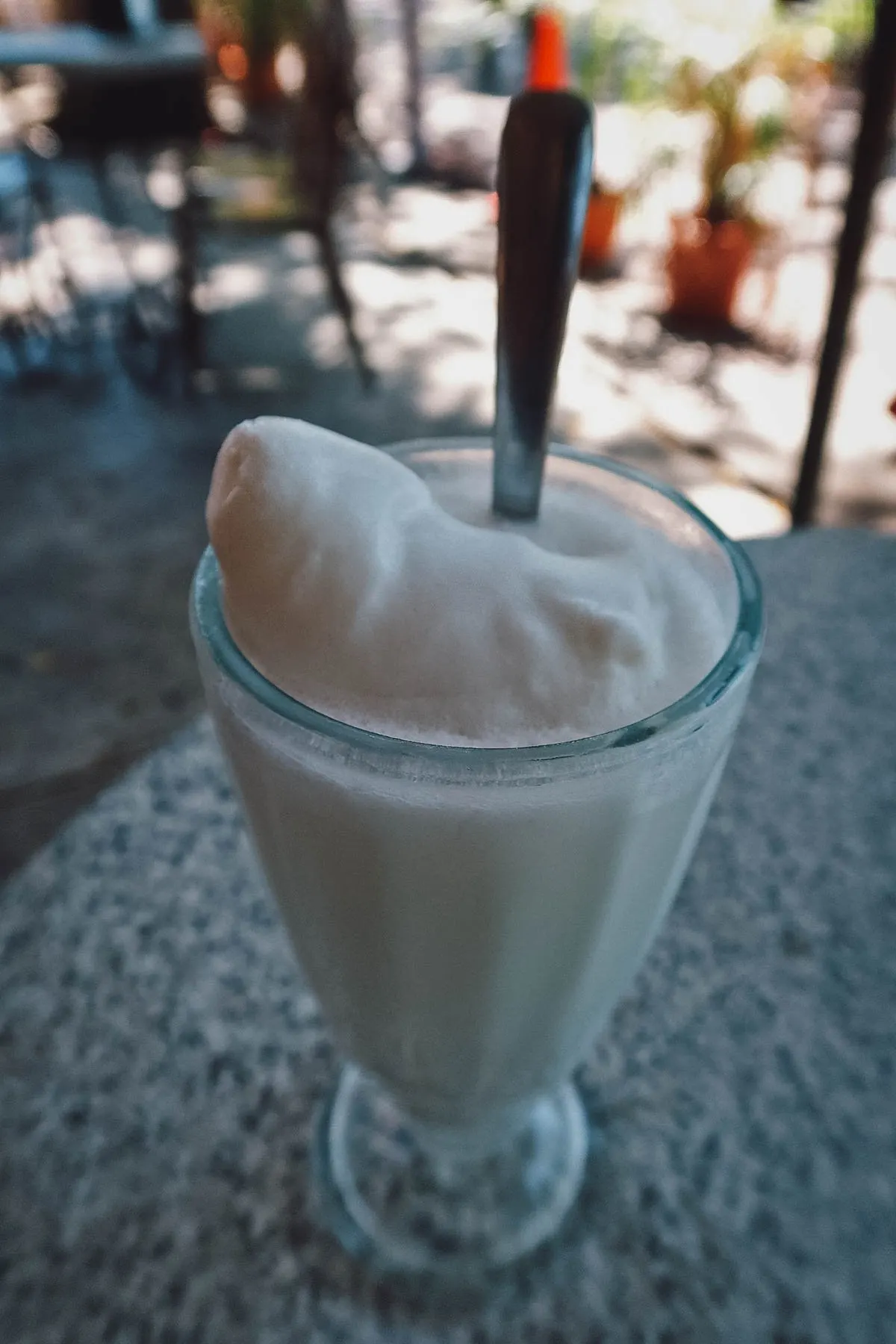
24. Machacados
Machacados is another refreshing dessert/drink from the Yucatan Peninsula. It’s originally from Chetumal in Quintana Roo though you can find it in other cities throughout the Riviera Maya like Cancun, Cozumel, and Playa del Carmen.
Machacados are very similar to raspados except they’re made with condensed milk and crushed fruit instead of the usual flavored syrups.
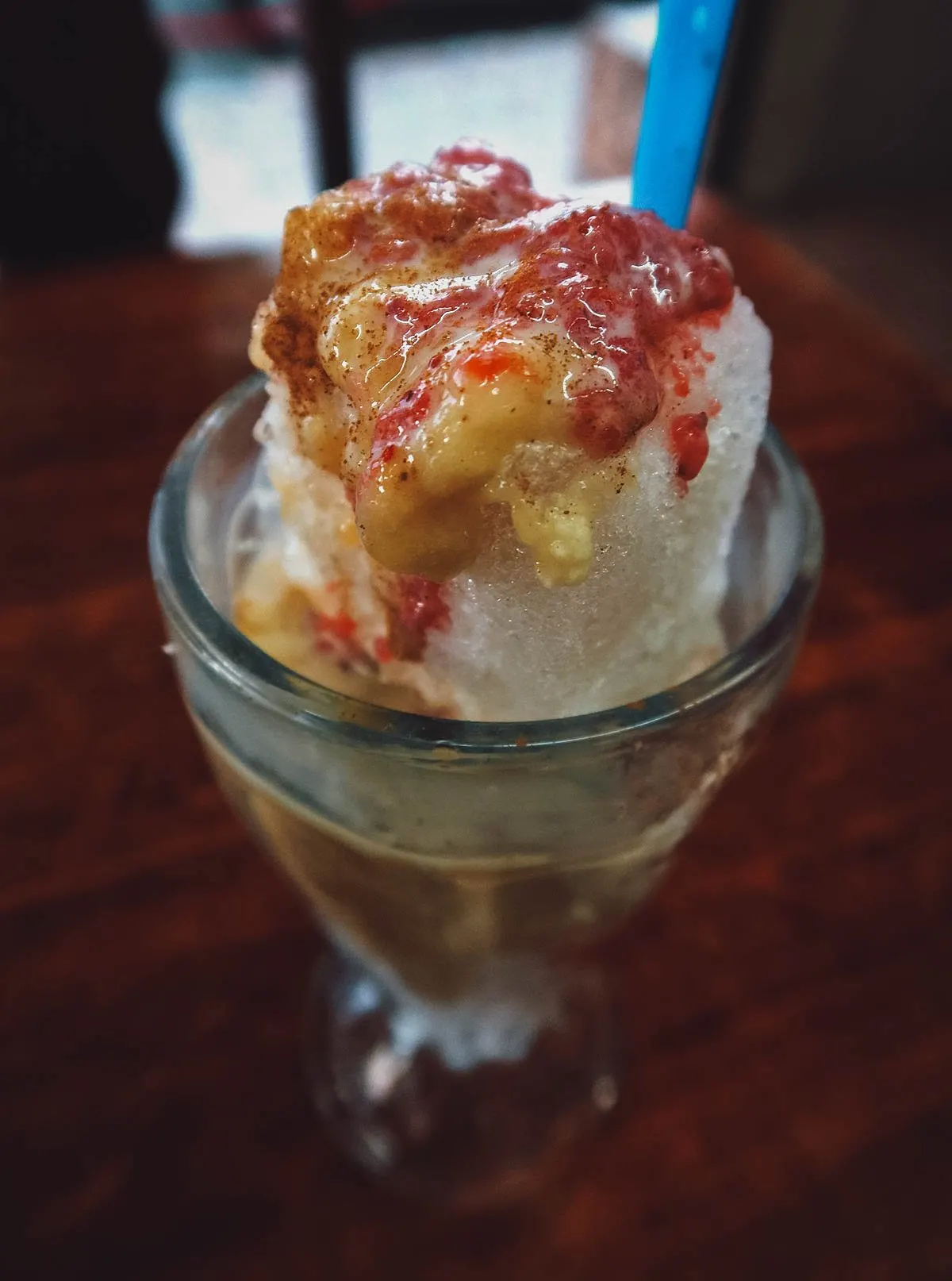
25. Agua de Chaya con Piña
After trying chaya for the first time at a restaurant in Merida, it quickly became one of my favorite Mexican drinks.
As previously described, chaya refers to a type of chard-like shrub native to the Yucatan. It’s used as an ingredient in many savory dishes but I enjoyed it most as a cold beverage.
Chaya can be pureed into a refreshing drink with just water and sugar but it can also be mixed with pineapple or lemon. I tried all three and I enjoyed them all. It’s sweet and herby in flavor, but in a good way.
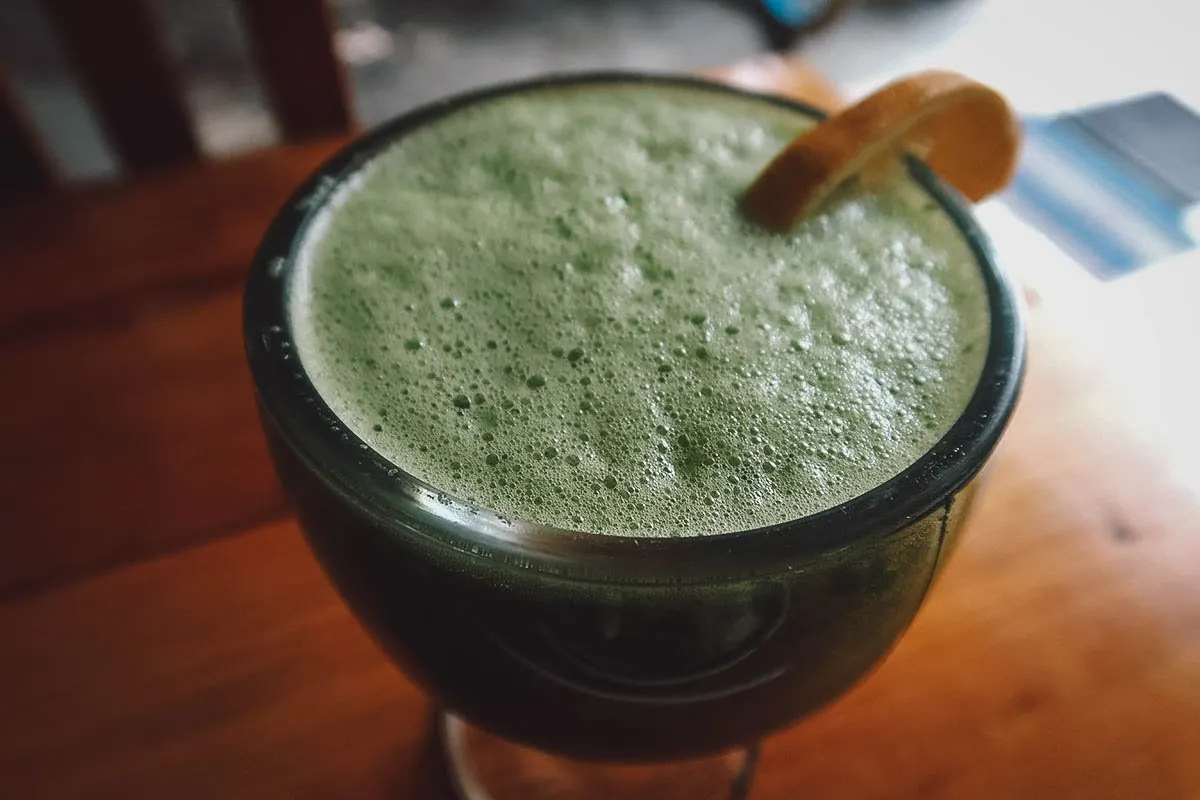
YUCATAN FOOD TOURS
Needless to say, no one knows Yucatan food like a local, so what better way to experience the best of Yucatan cuisine than by going on a guided food tour?
Not only will a food-obsessed local take you to the city’s best markets, restaurants, and street food stalls, but they can give you tidbits of information that you simply can’t find on Google. Check our Get Your Guide for a list of food tours in different cities throughout the Yucatan Peninsula.
YUCATAN COOKING CLASSES
If you want to do a deep dive into Yucatan cuisine, then you may be interested in taking a cooking class. It’s one of the best ways to learn about Mayan food because it gives you a chance to work with the local ingredients that go behind each dish.
If you’re adept in the kitchen and want to take a cooking class in the Yucatan, then check out Cookly for a list of classes in Merida and the Riviera Maya.
FINAL THOUGHTS ON MAYAN CUISINE
At the time of this writing, I’ve been traveleating through Mexico for almost six months and Yucatecan food is some of the most interesting I’ve enjoyed so far. It’s definitely up there with Oaxacan and Pueblan food.
The taste of sour oranges, habanero, and achiote is something I’ll always associate with Yucatan food. Pork is usually the last thing I order on a restaurant’s menu but well-seasoned dishes like cochinita, poc chuc, and longaniza de valladolid will have me craving for pork long after I leave the peninsula. The Yucatecan love for slow-roasted pork is palpable and easy to understand, simply because it’s so delicious.
Anyway, I hope you enjoyed reading this guide on the best Mayan dishes to try in the Yucatan. I certainly enjoyed writing (and doing field research for) it. We’ve fallen in love with Mexico and Mexican food so you can bet your queso relleno that we’ll be back.
Hasta luego and have a wonderful time eating your way through the Yucatan Peninsula!
Disclosure
Some of the links in this Yucatan food guide are affiliate links, meaning we’ll earn a small commission if you make a purchase at no added cost to you. As always, we only recommend products and services that we use ourselves and firmly believe in. We really appreciate your support as this helps us make more of these free travel guides. Muchas gracias!

